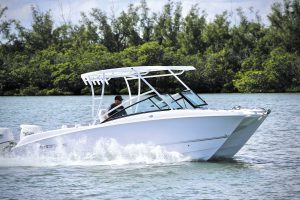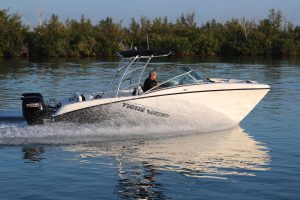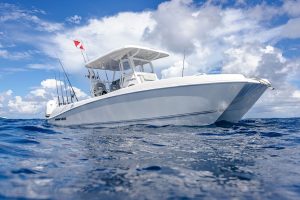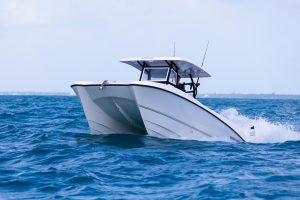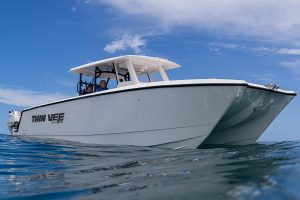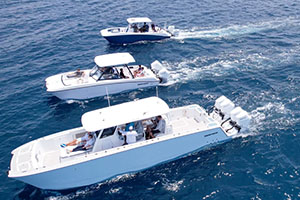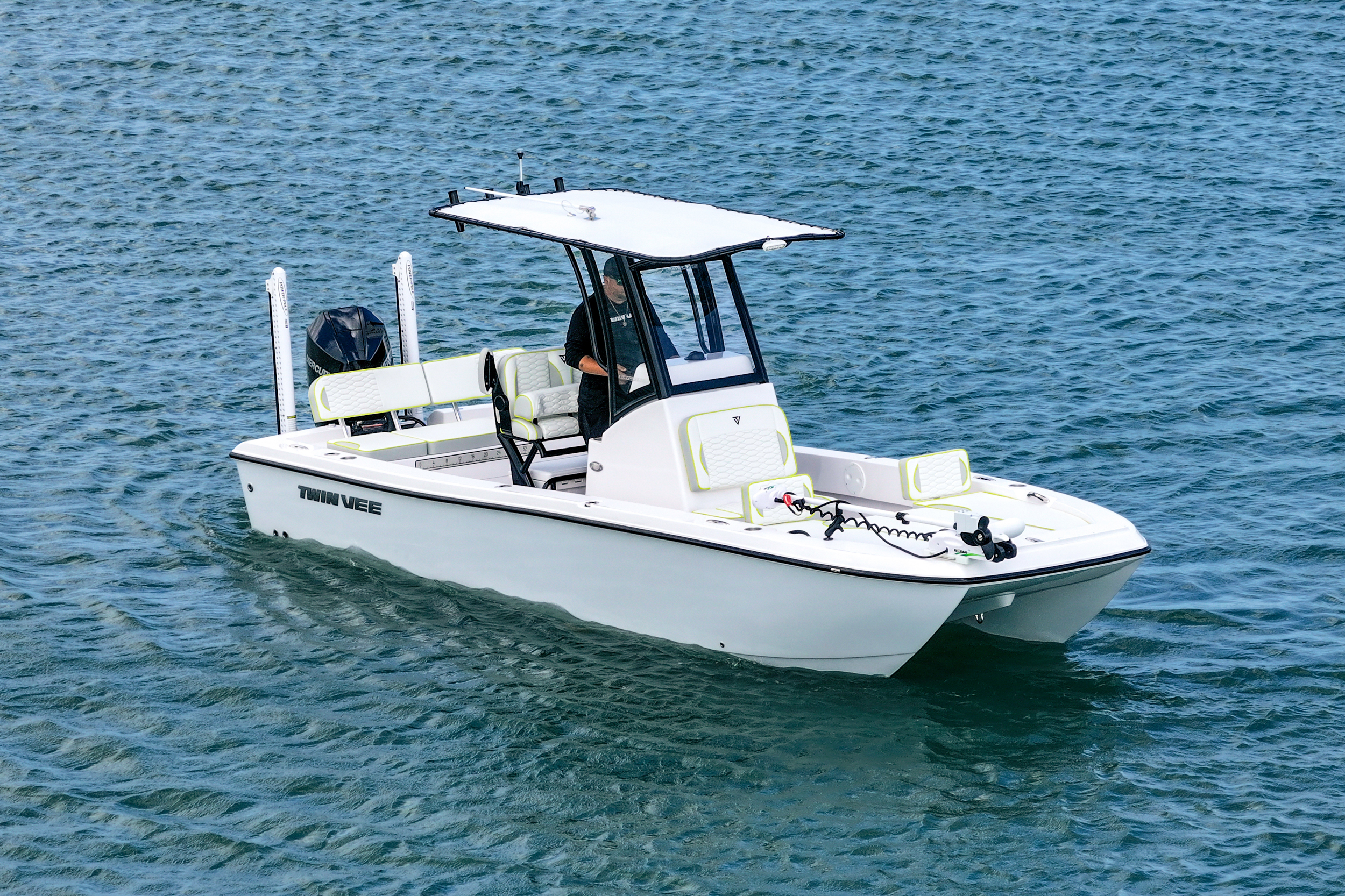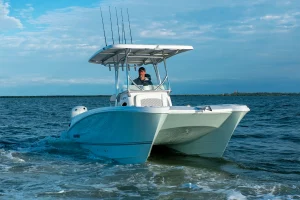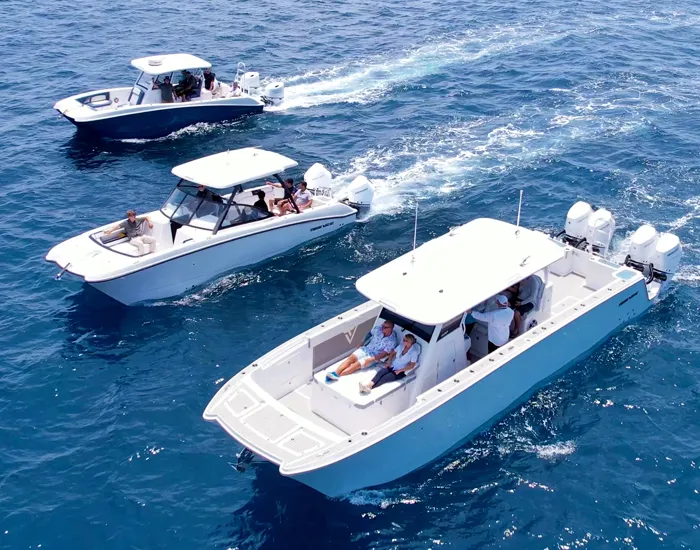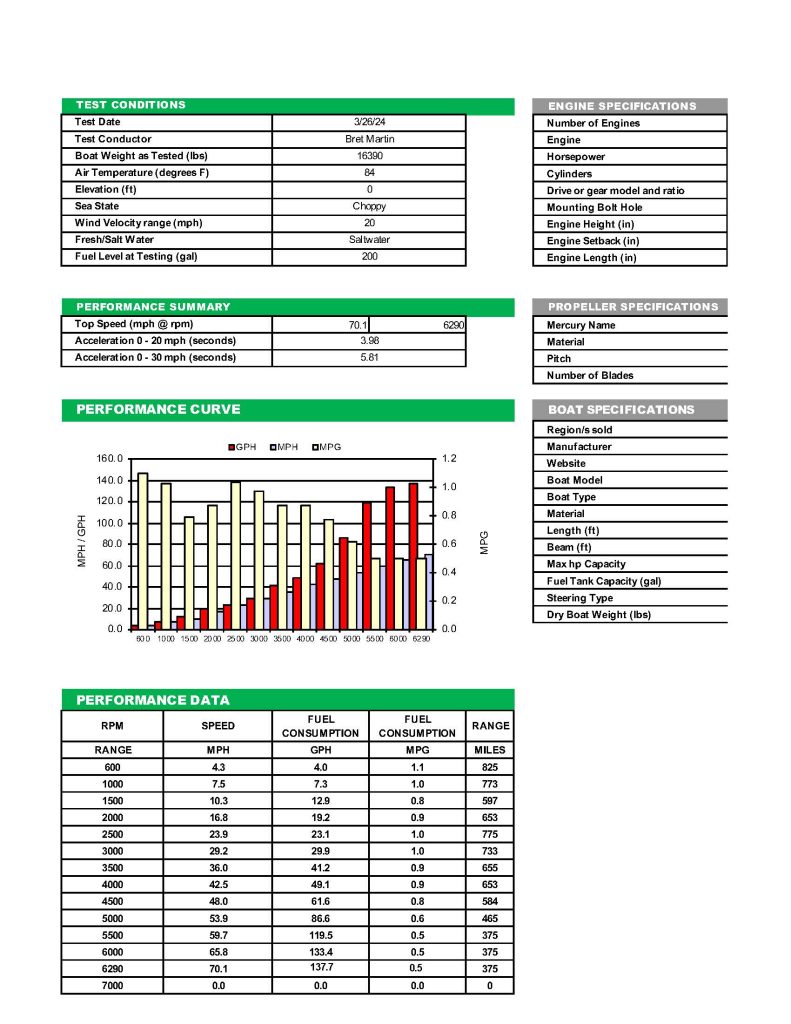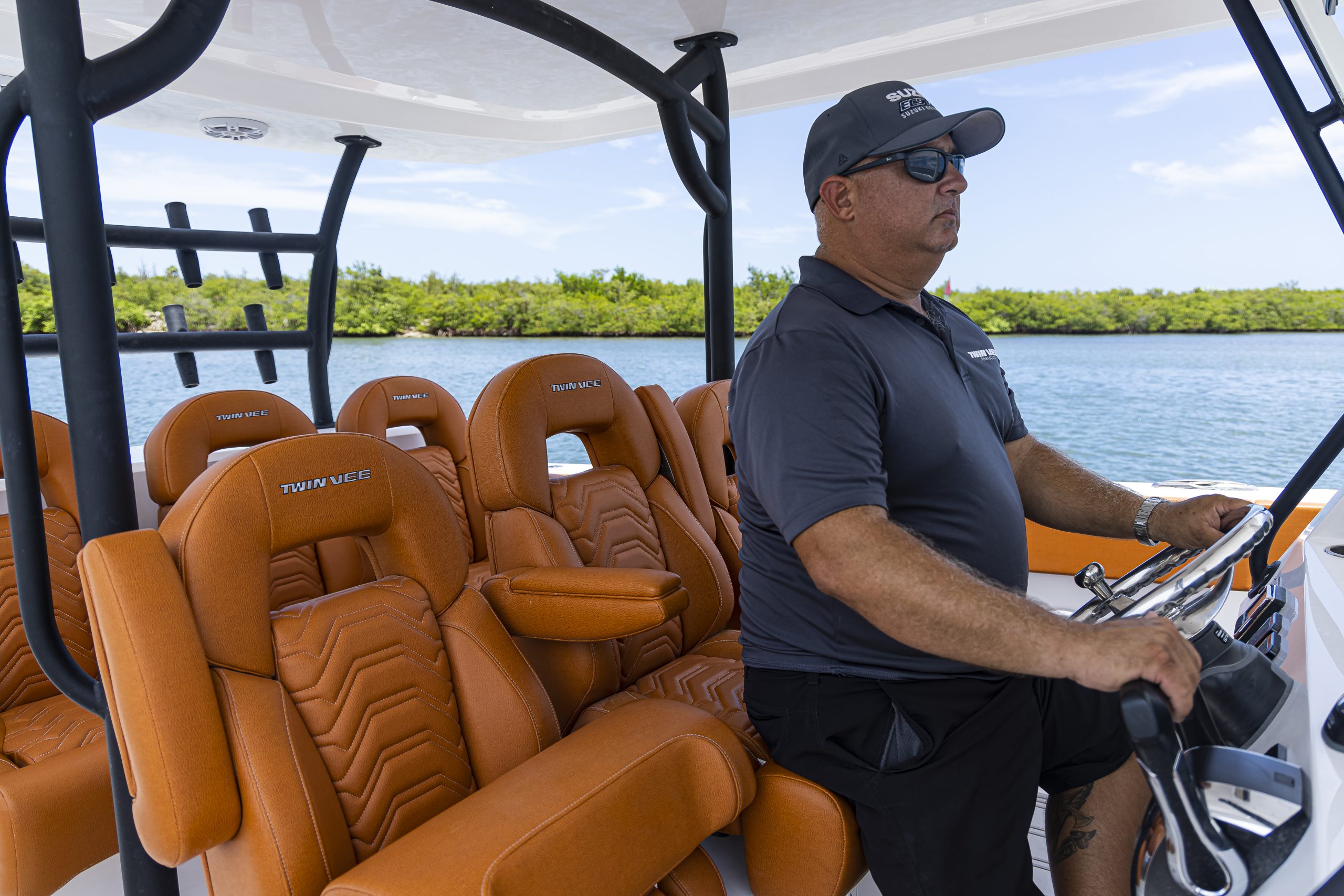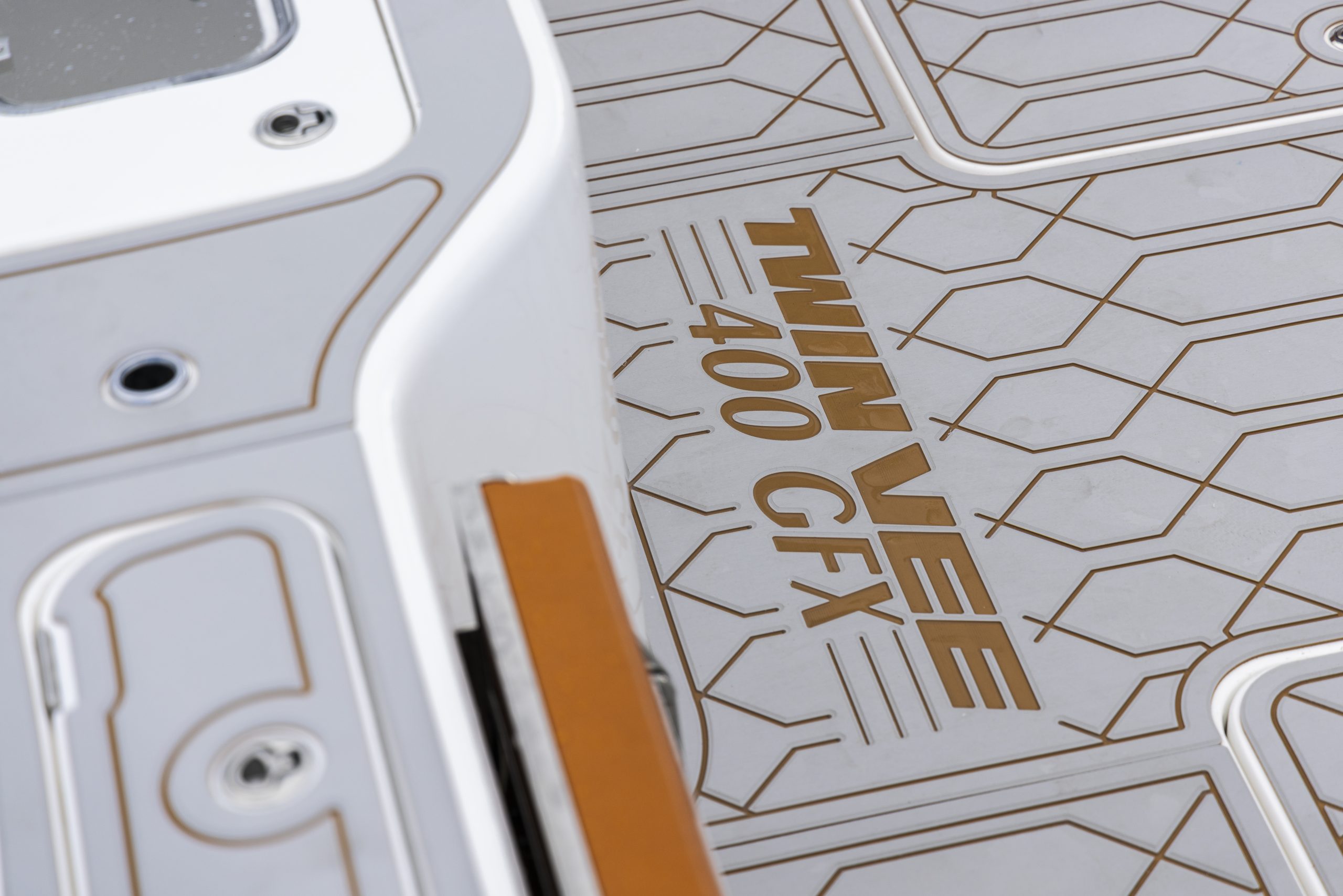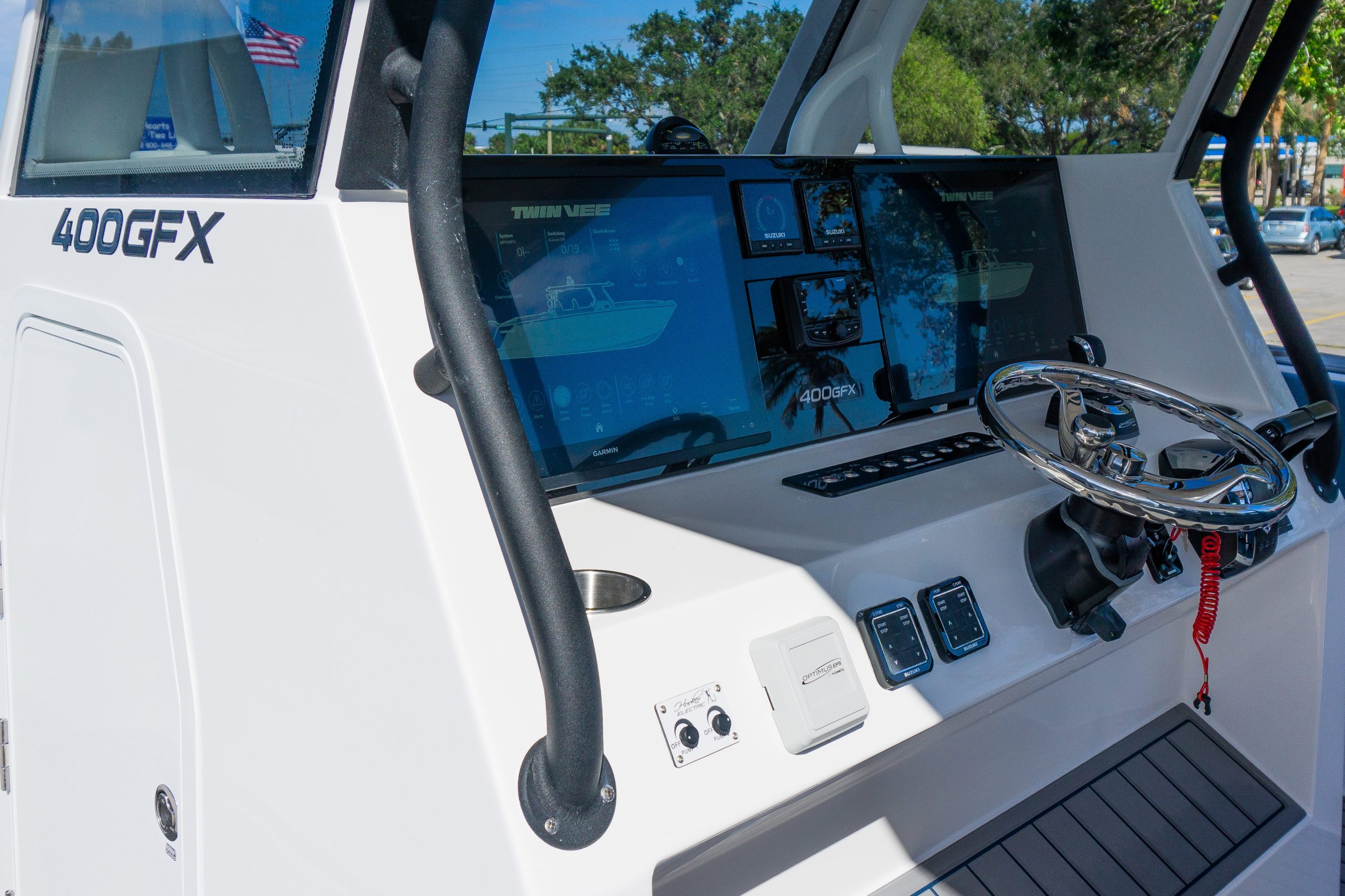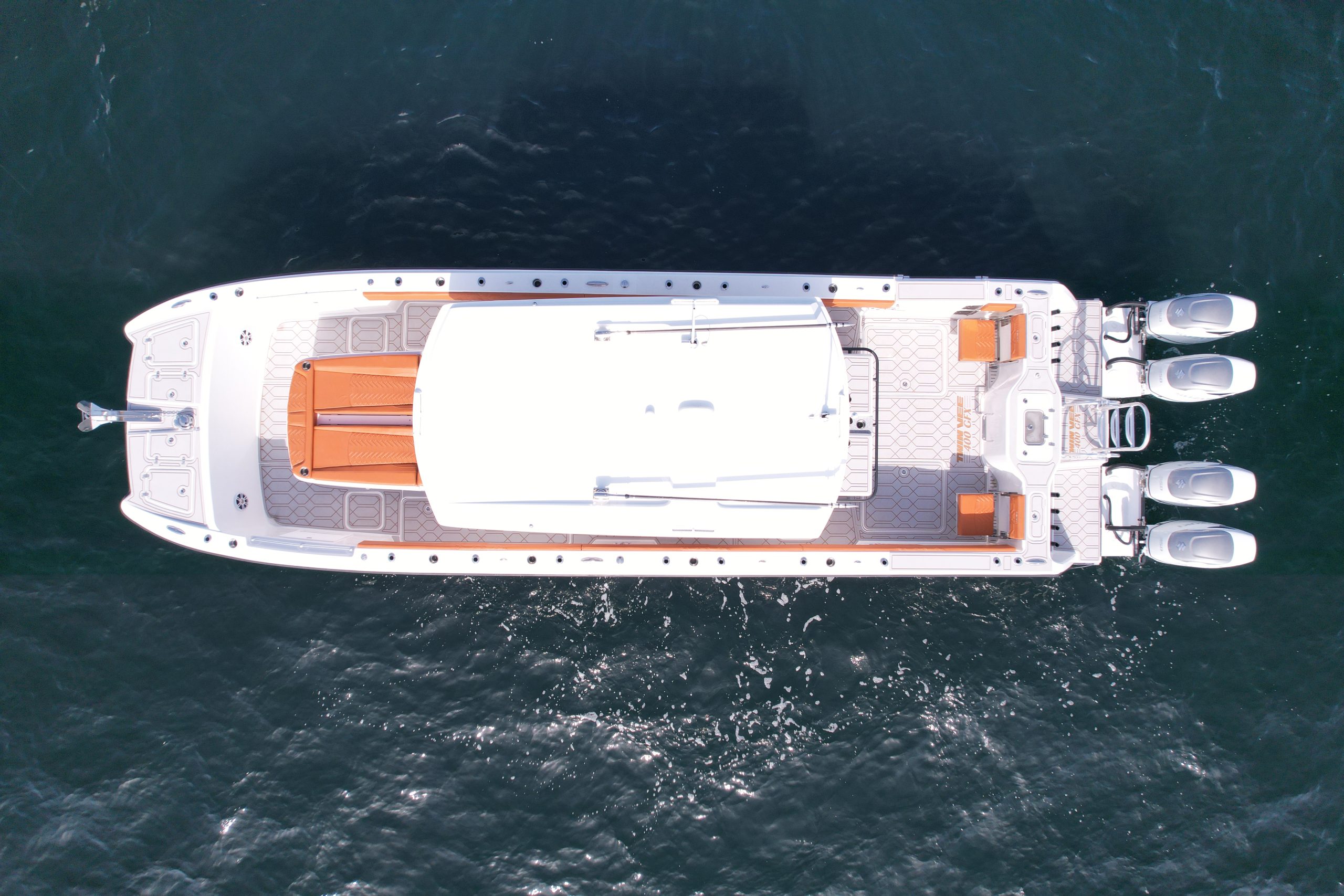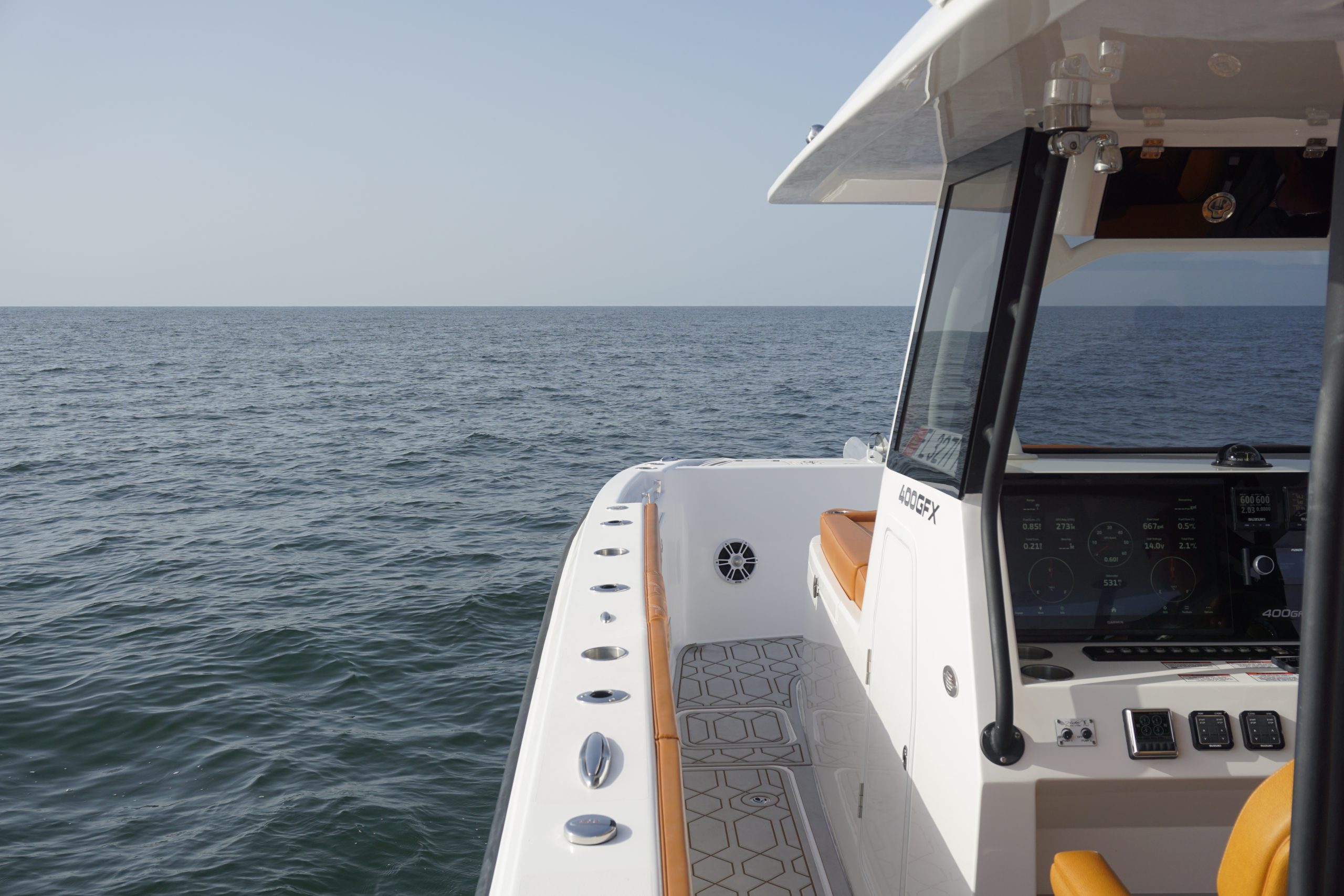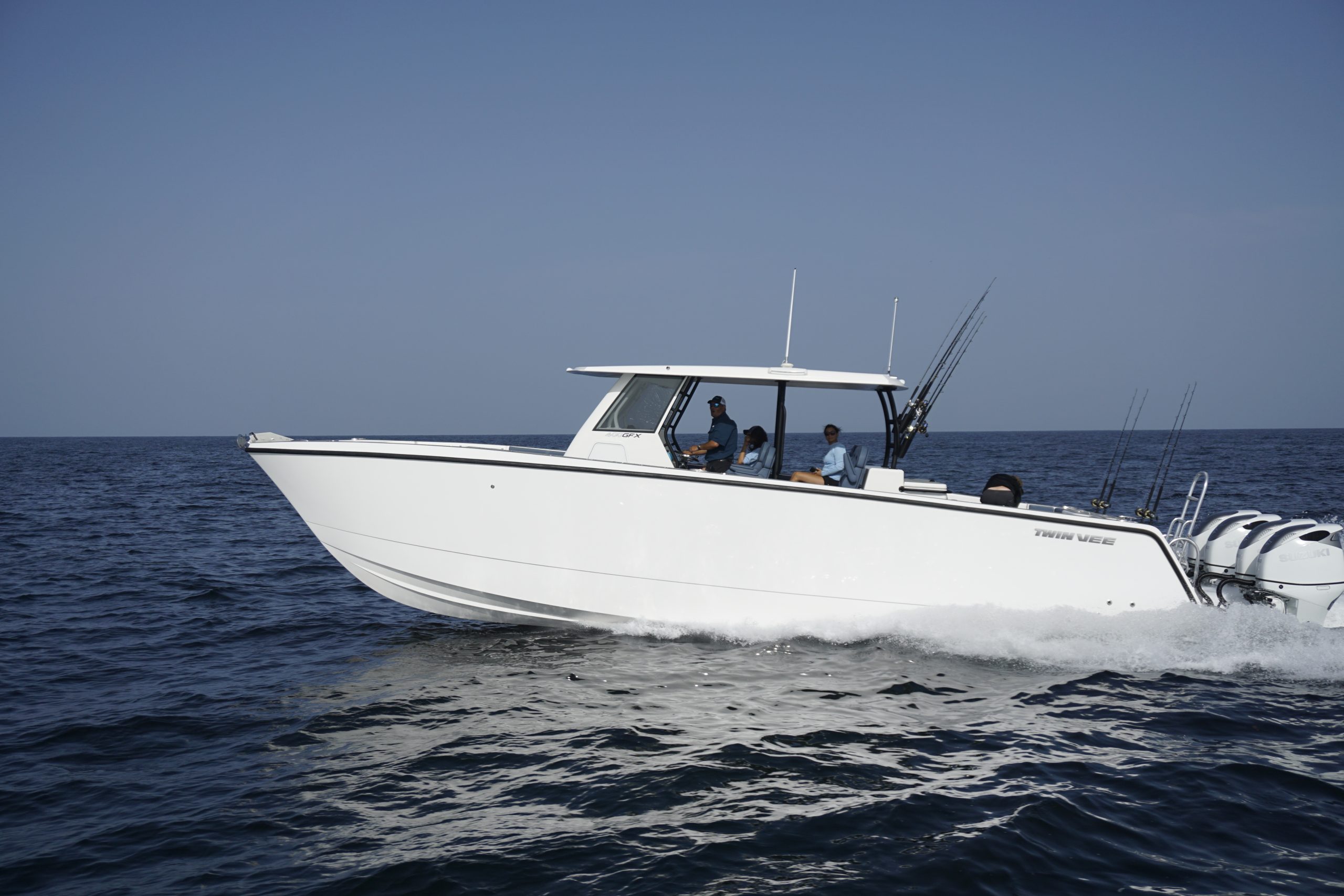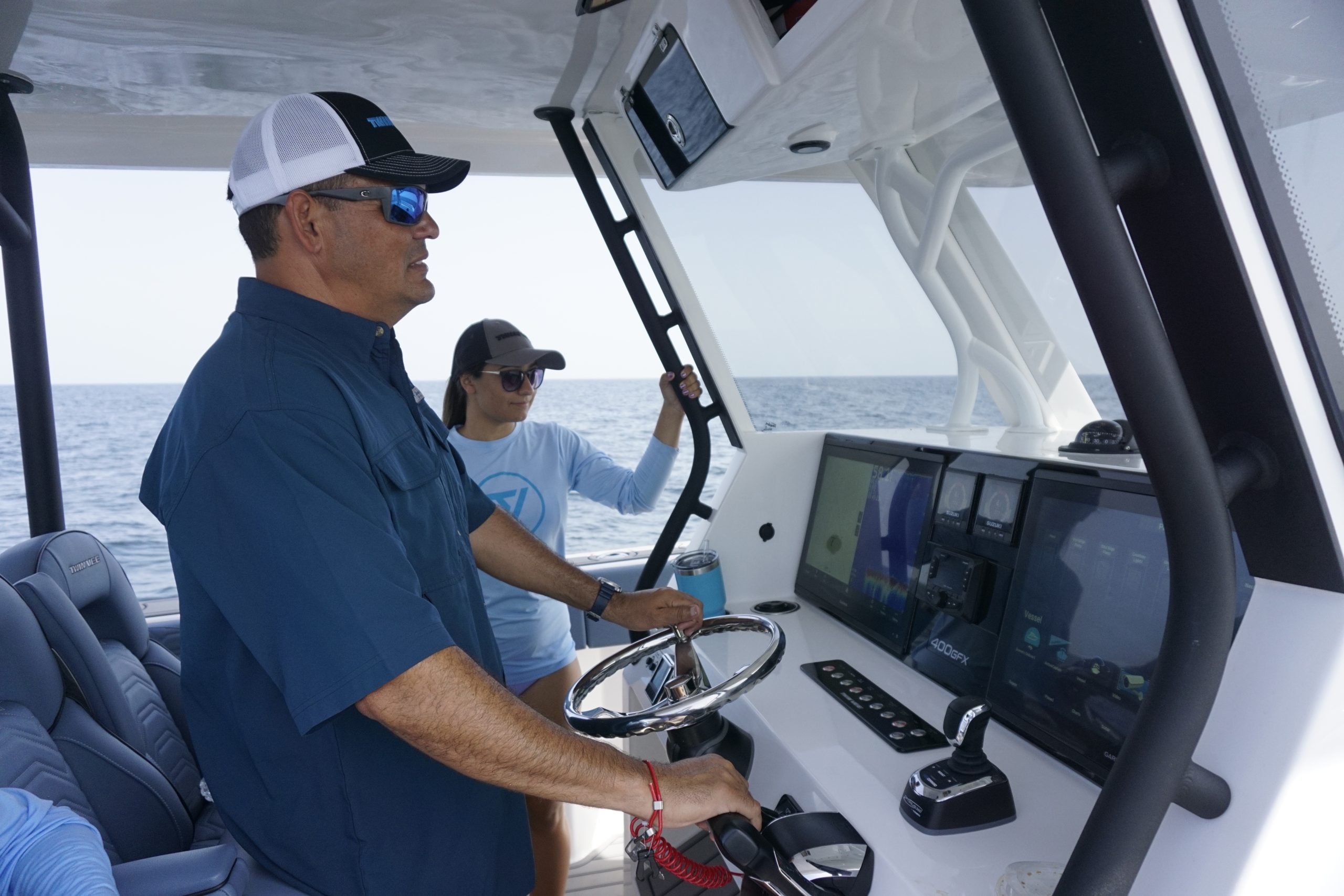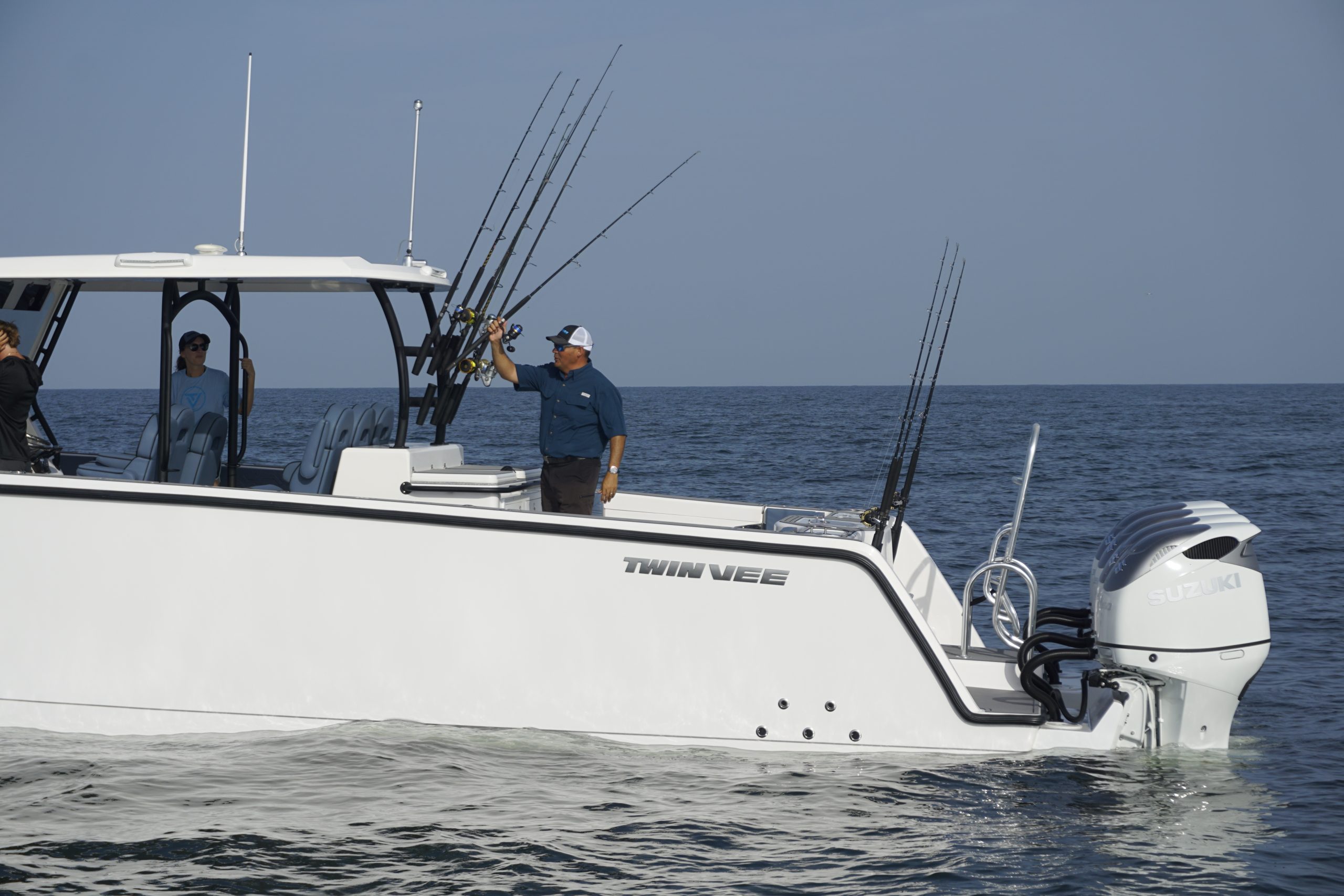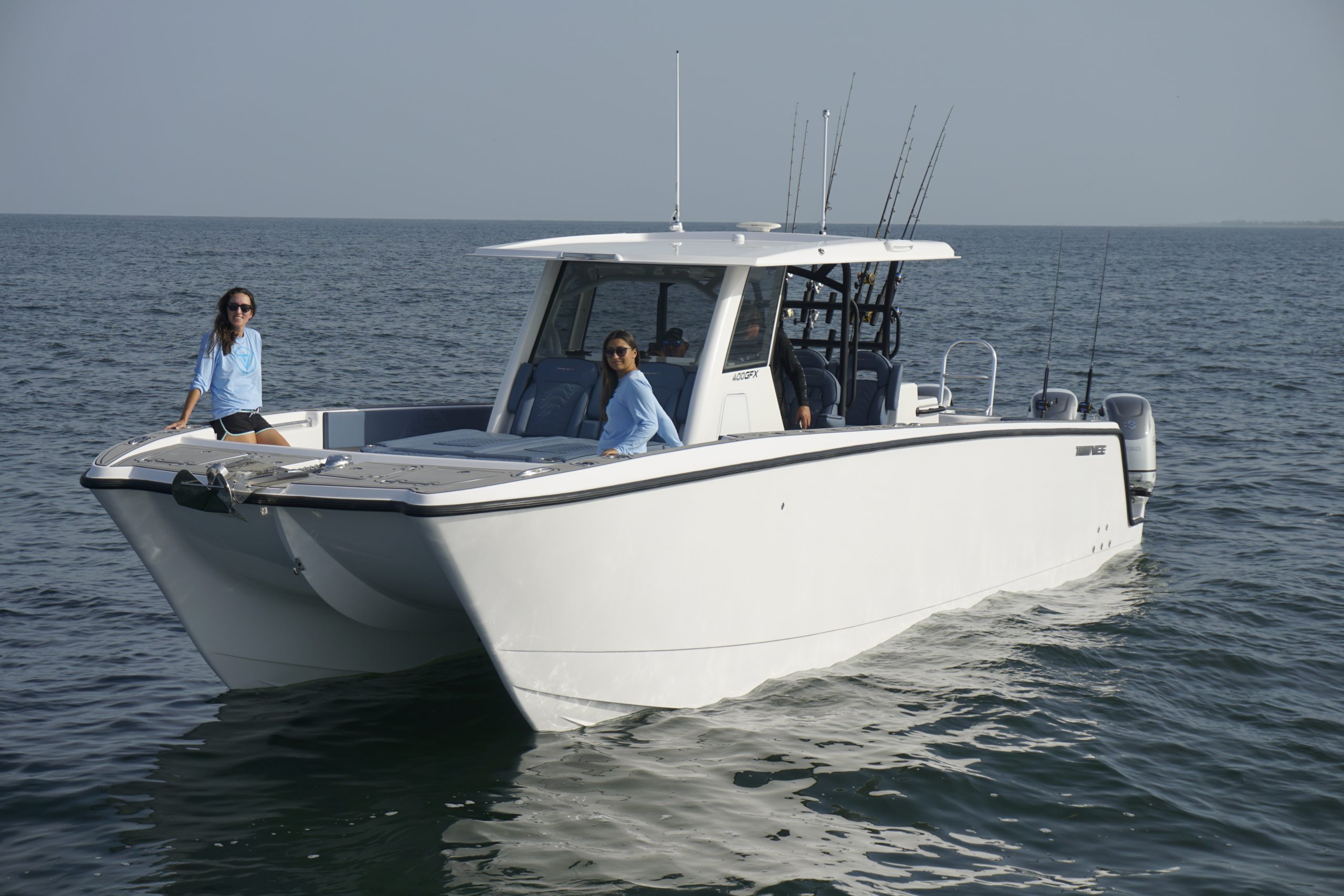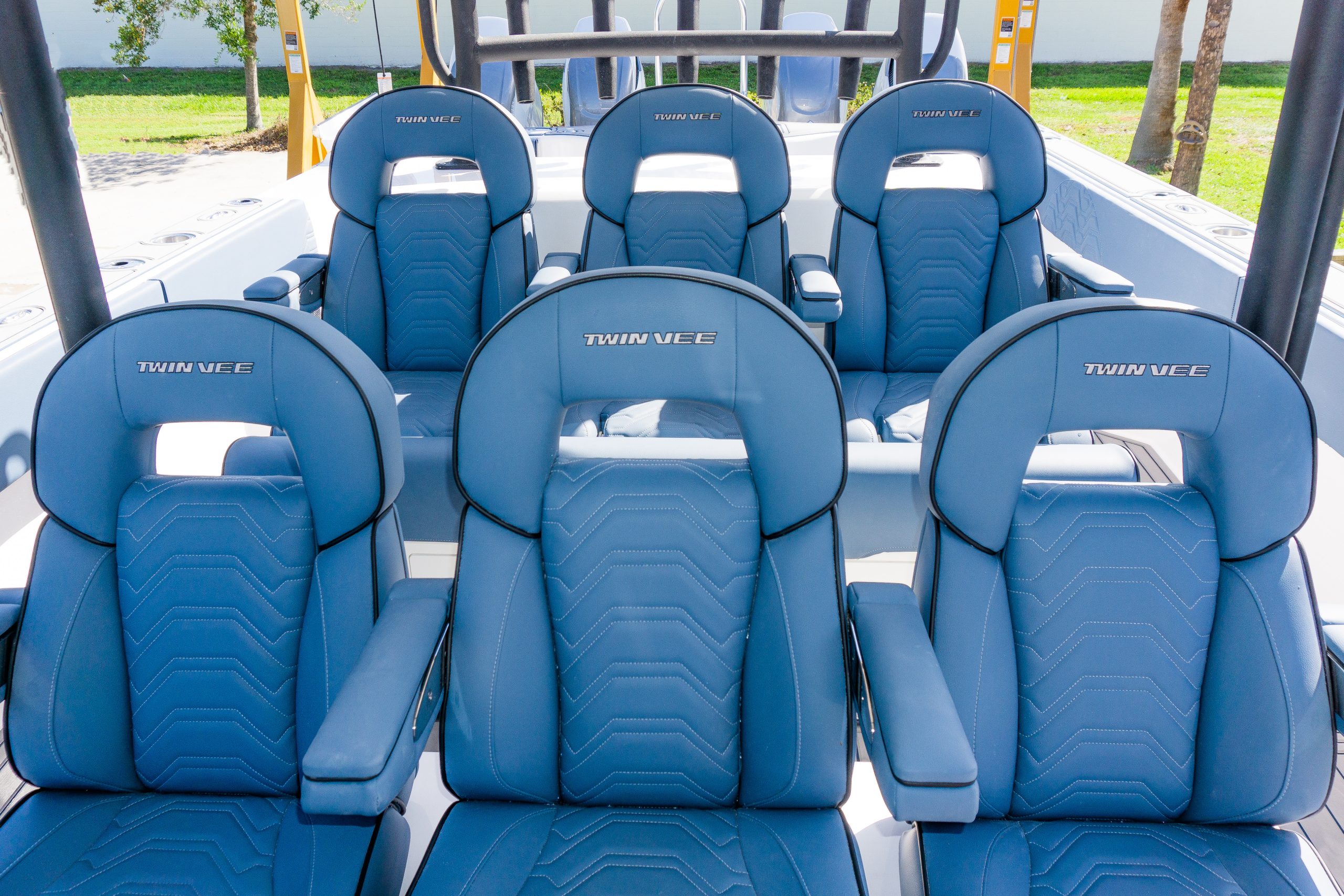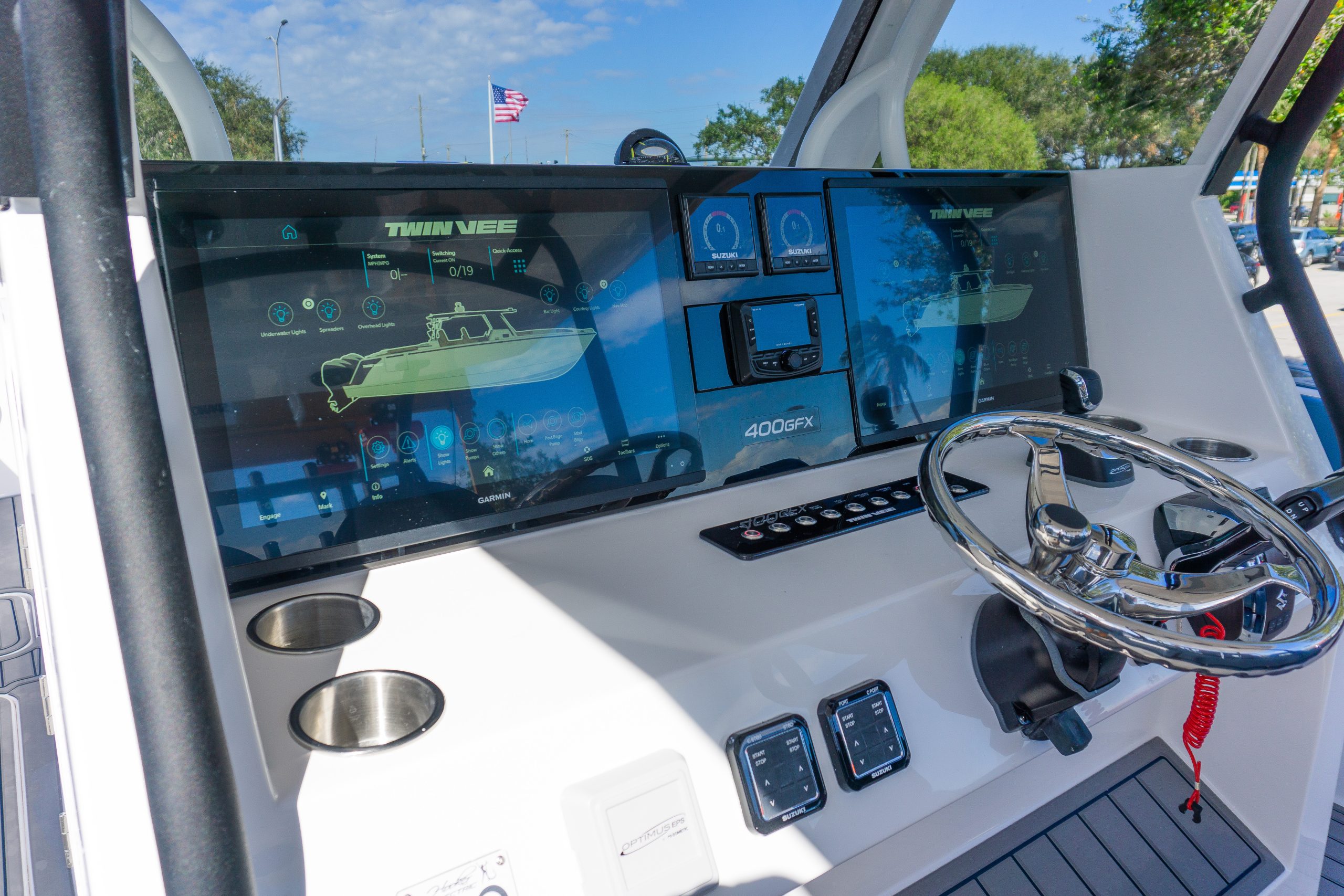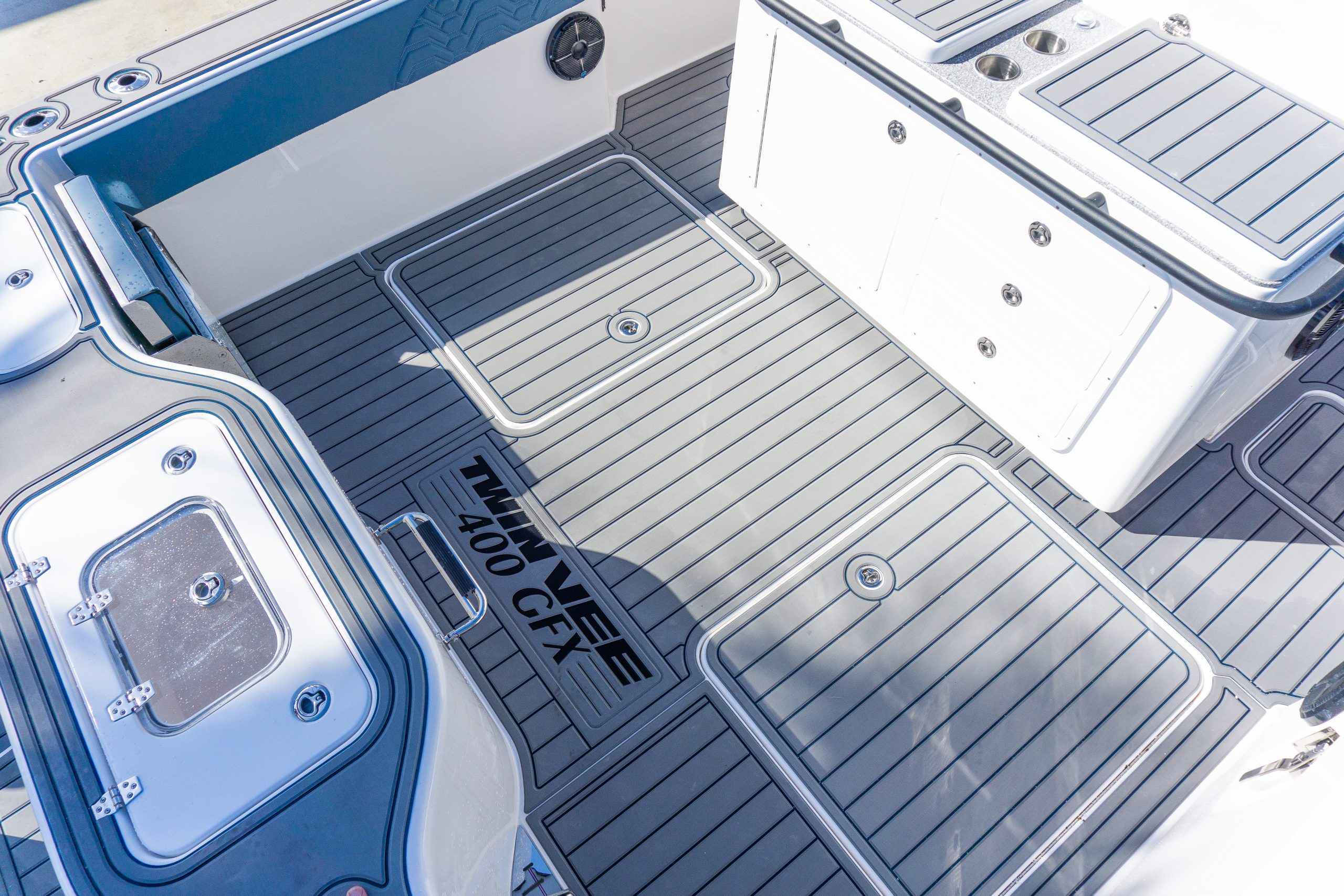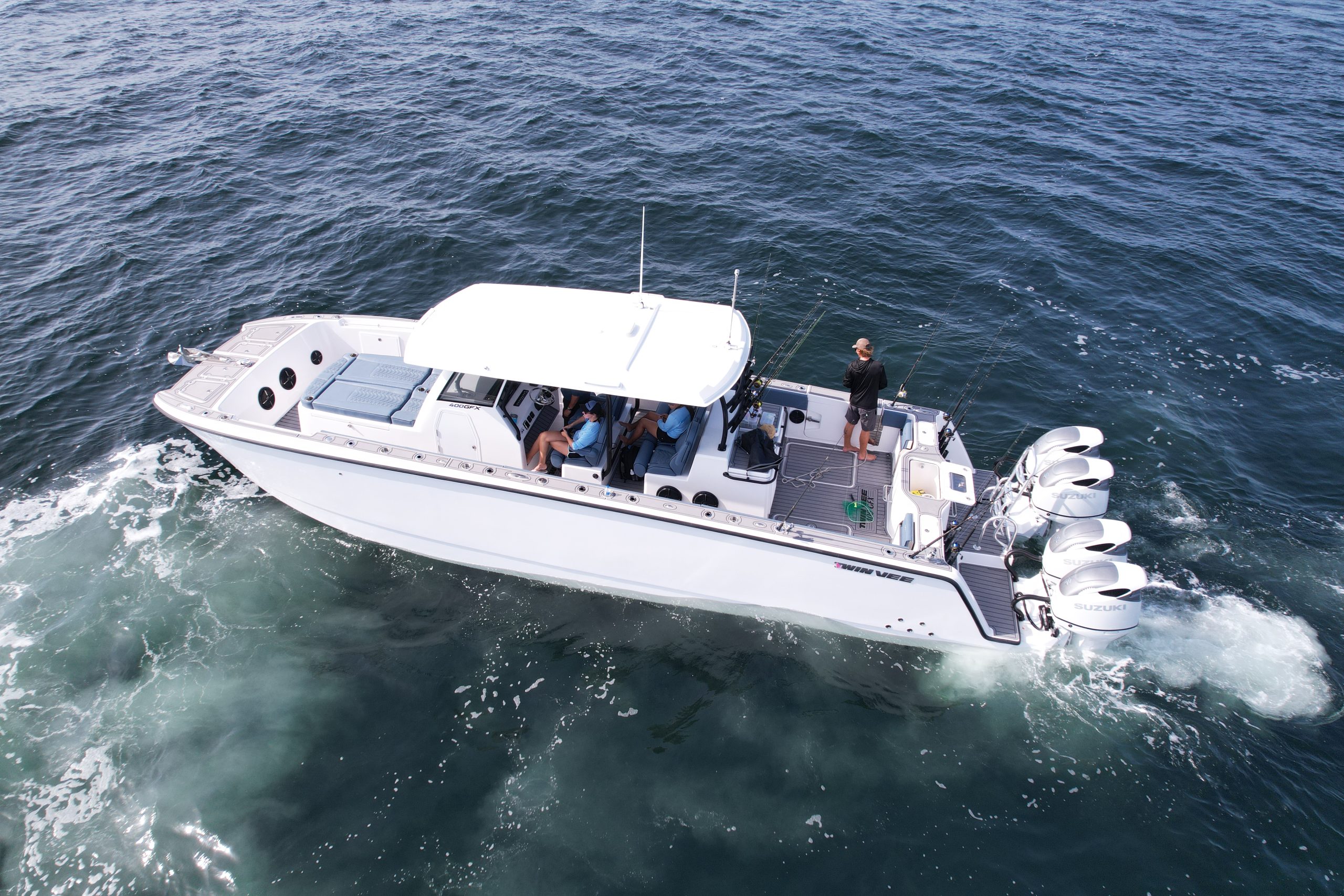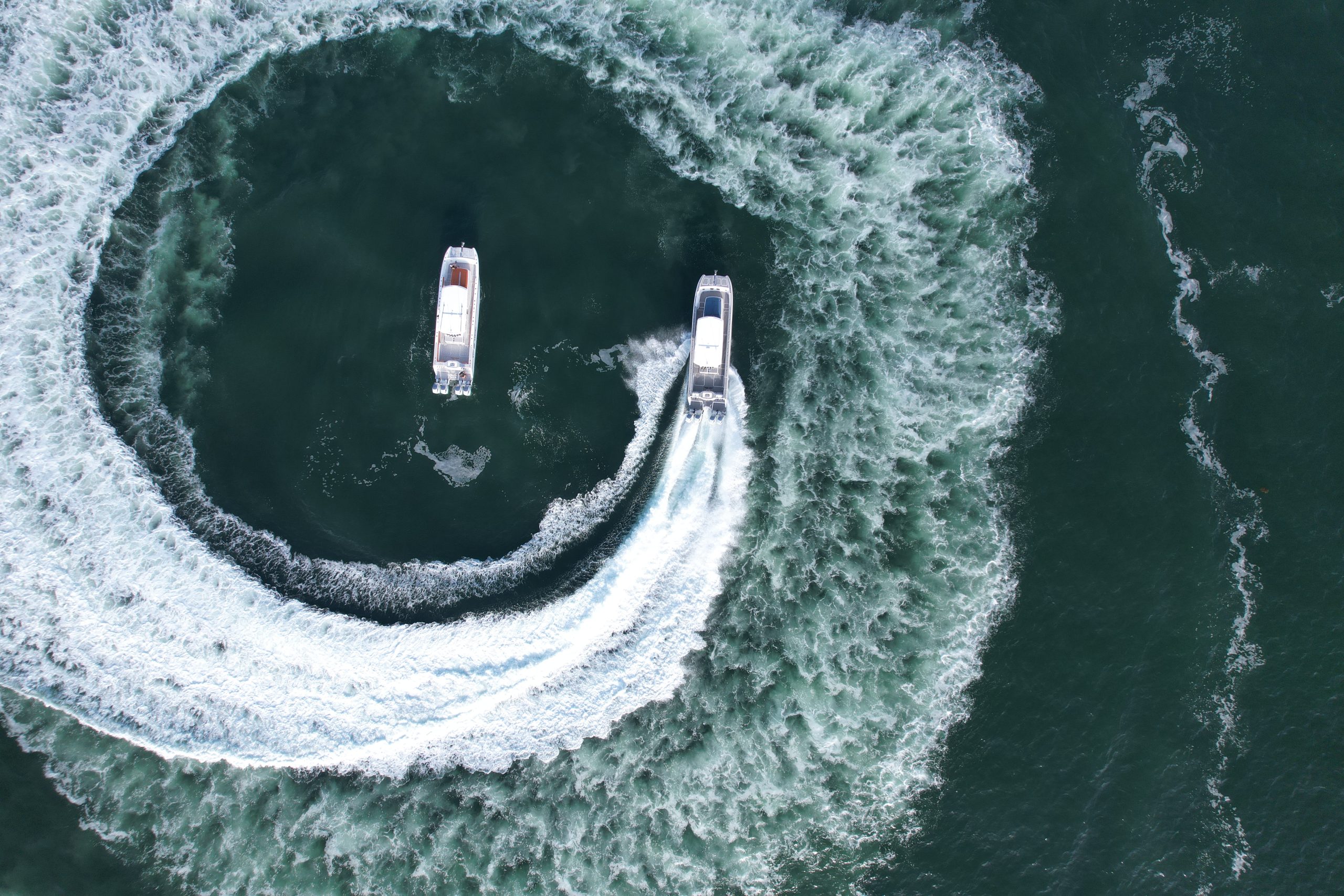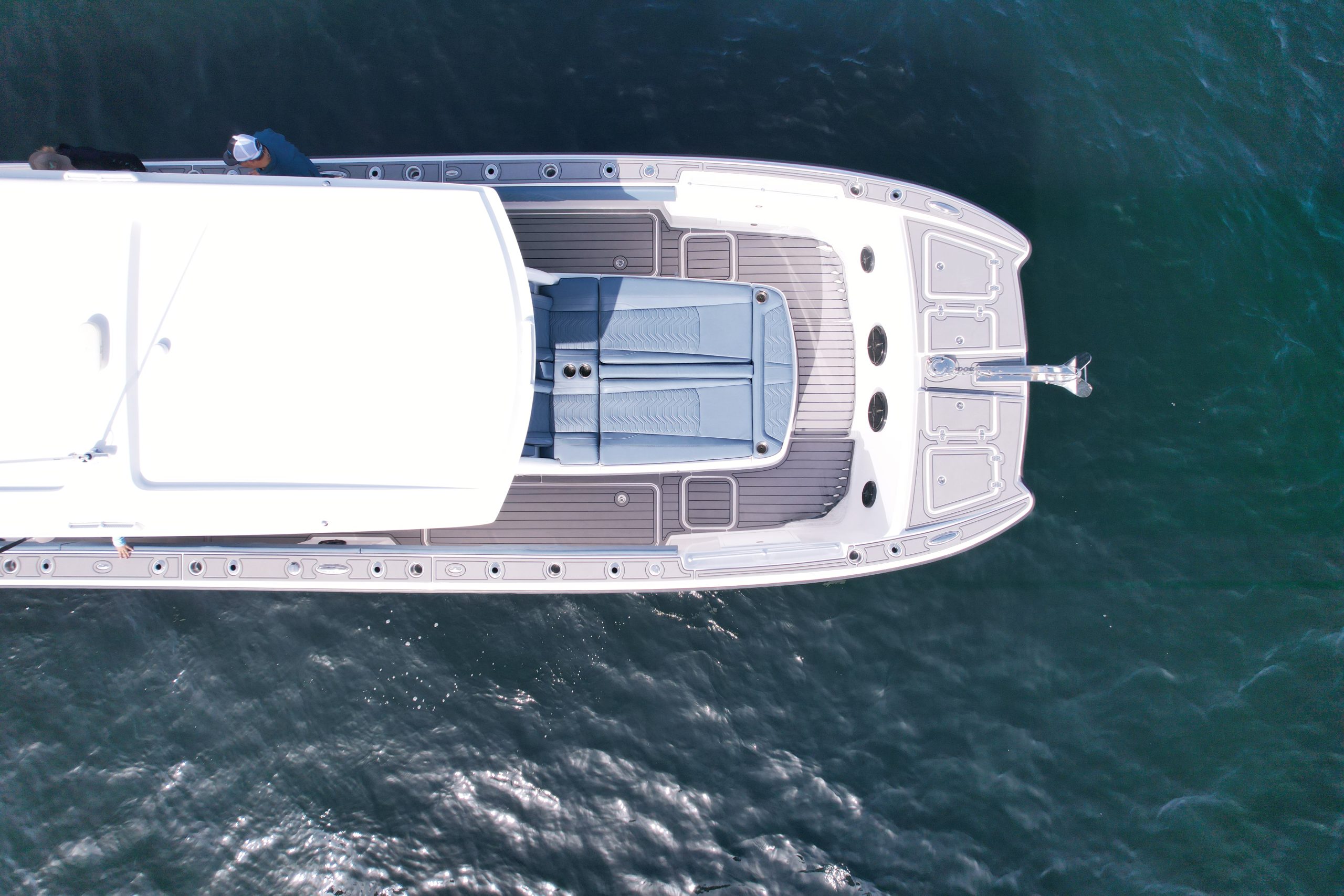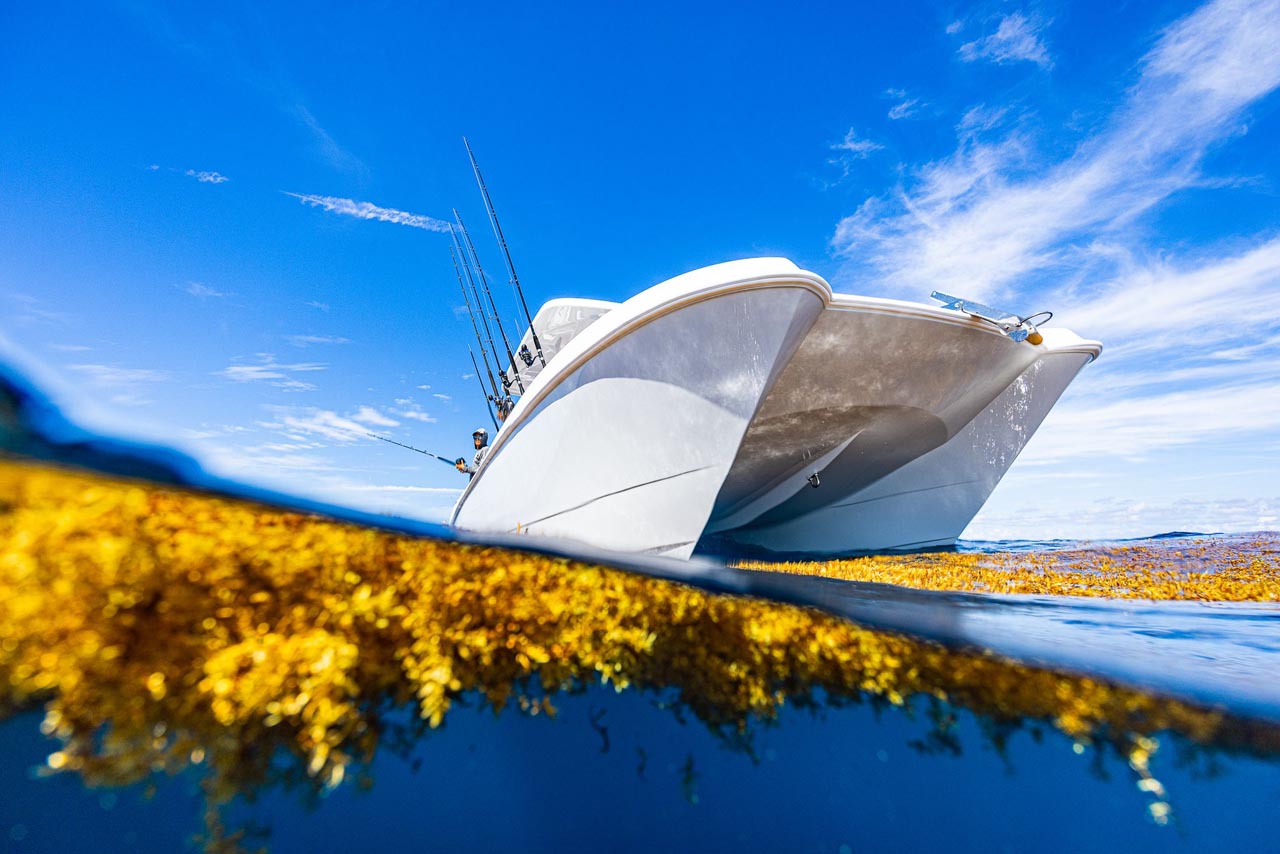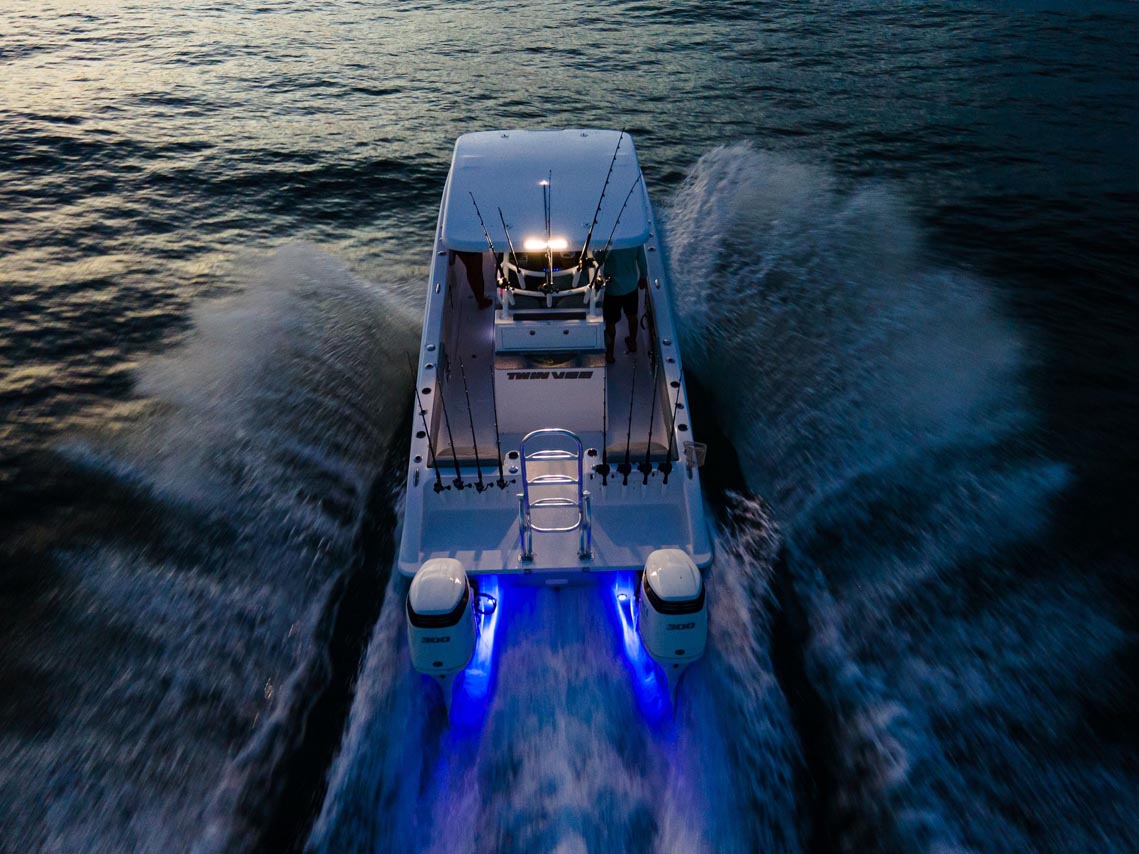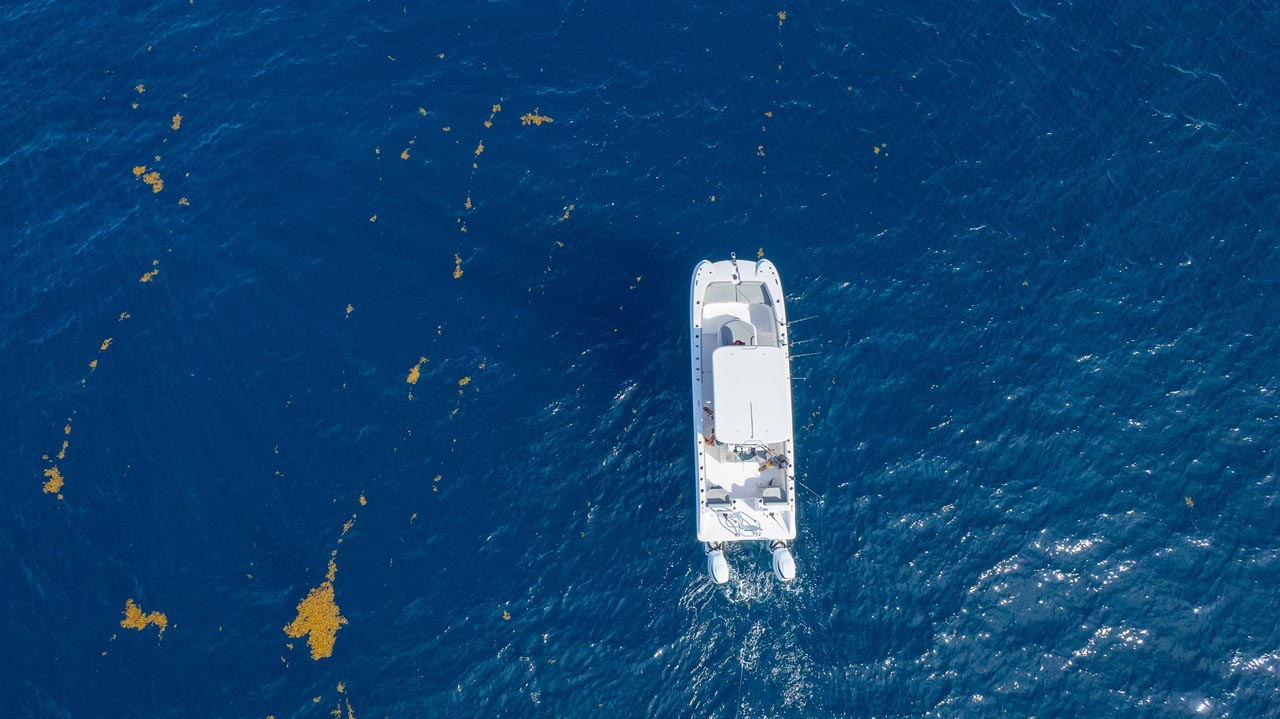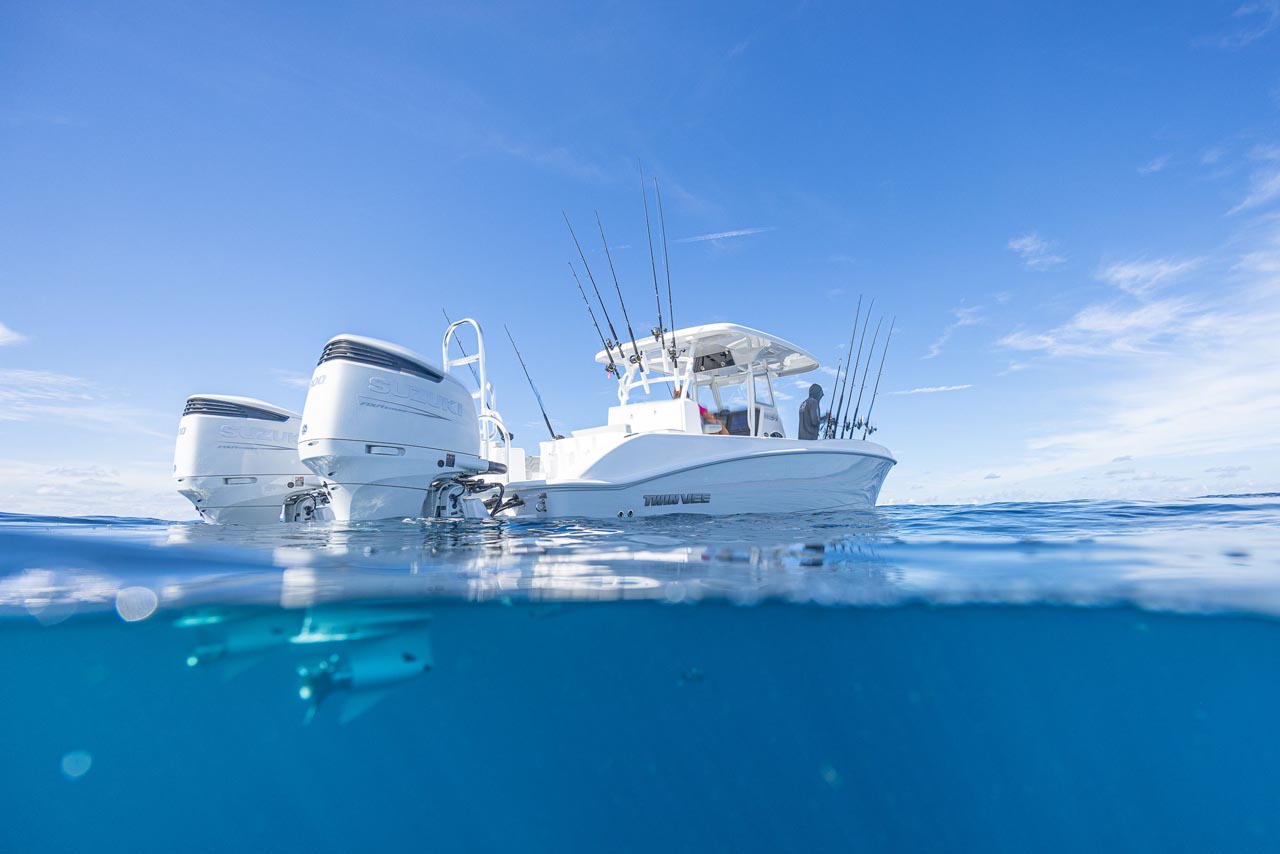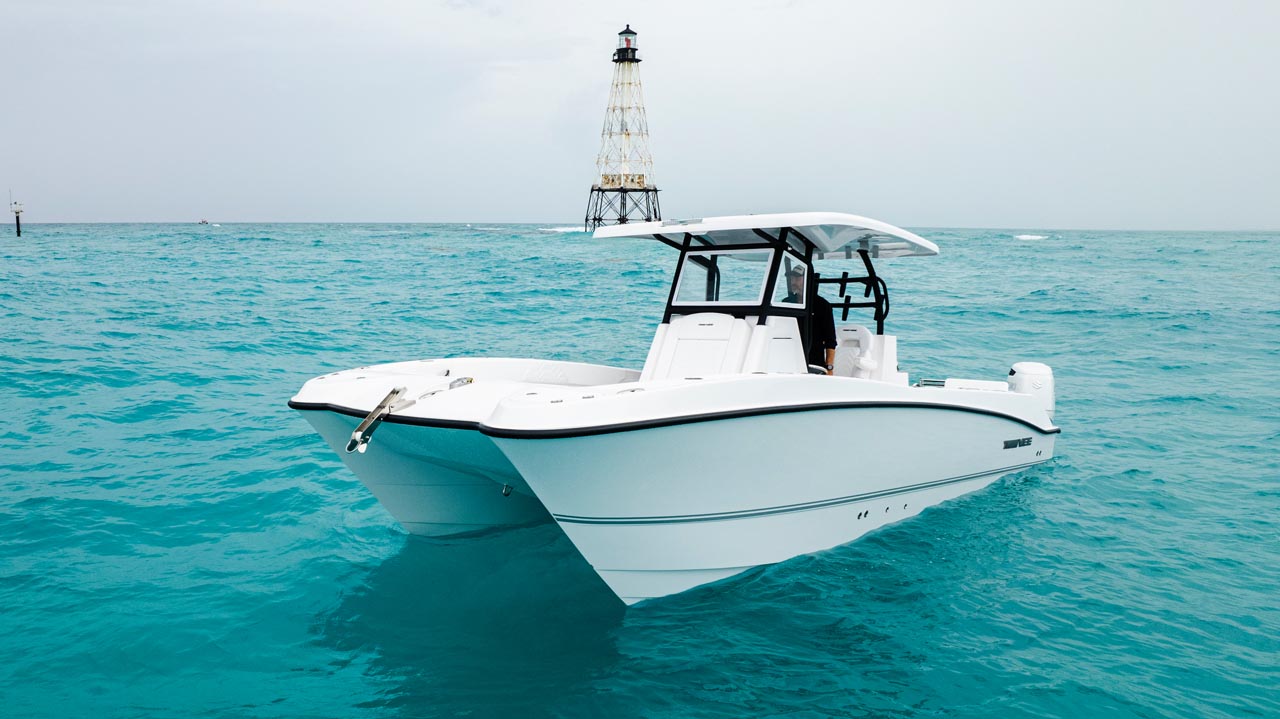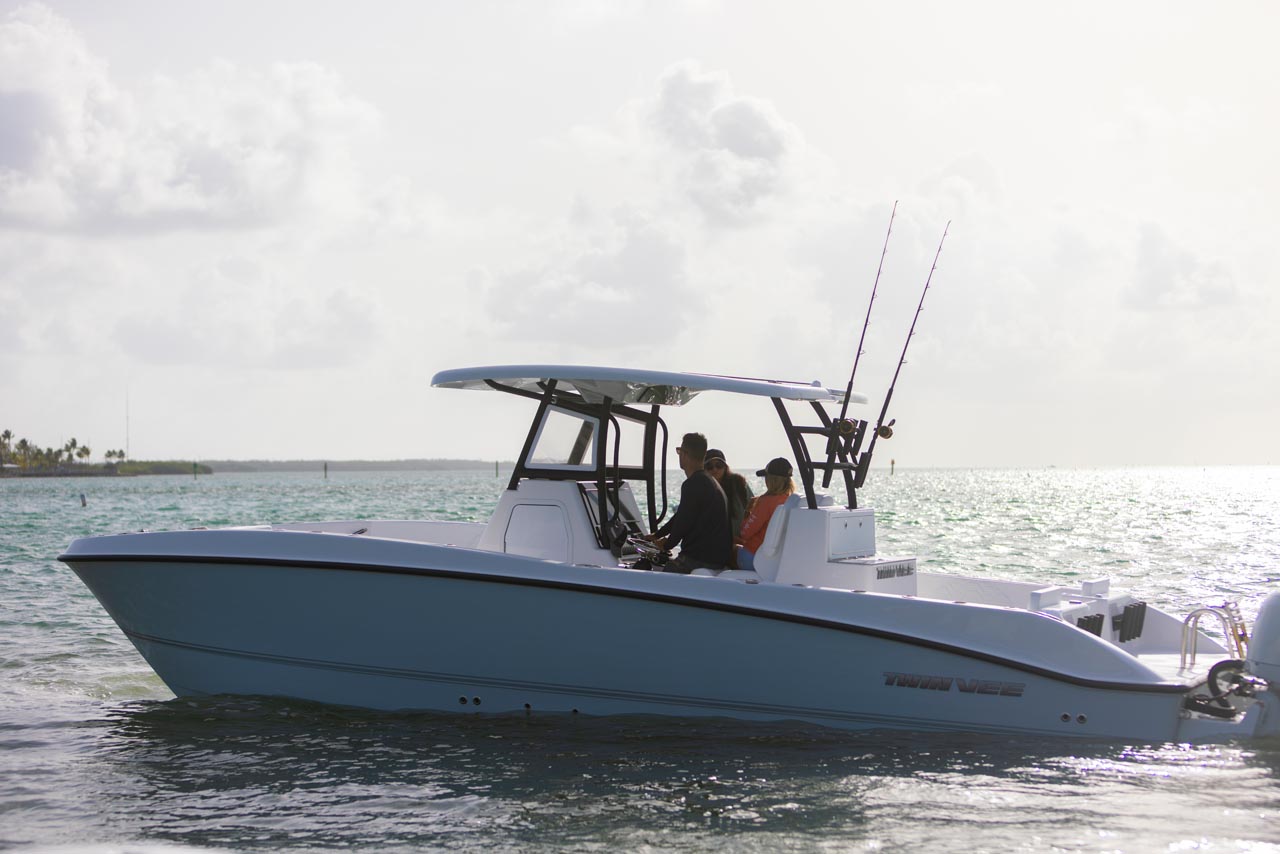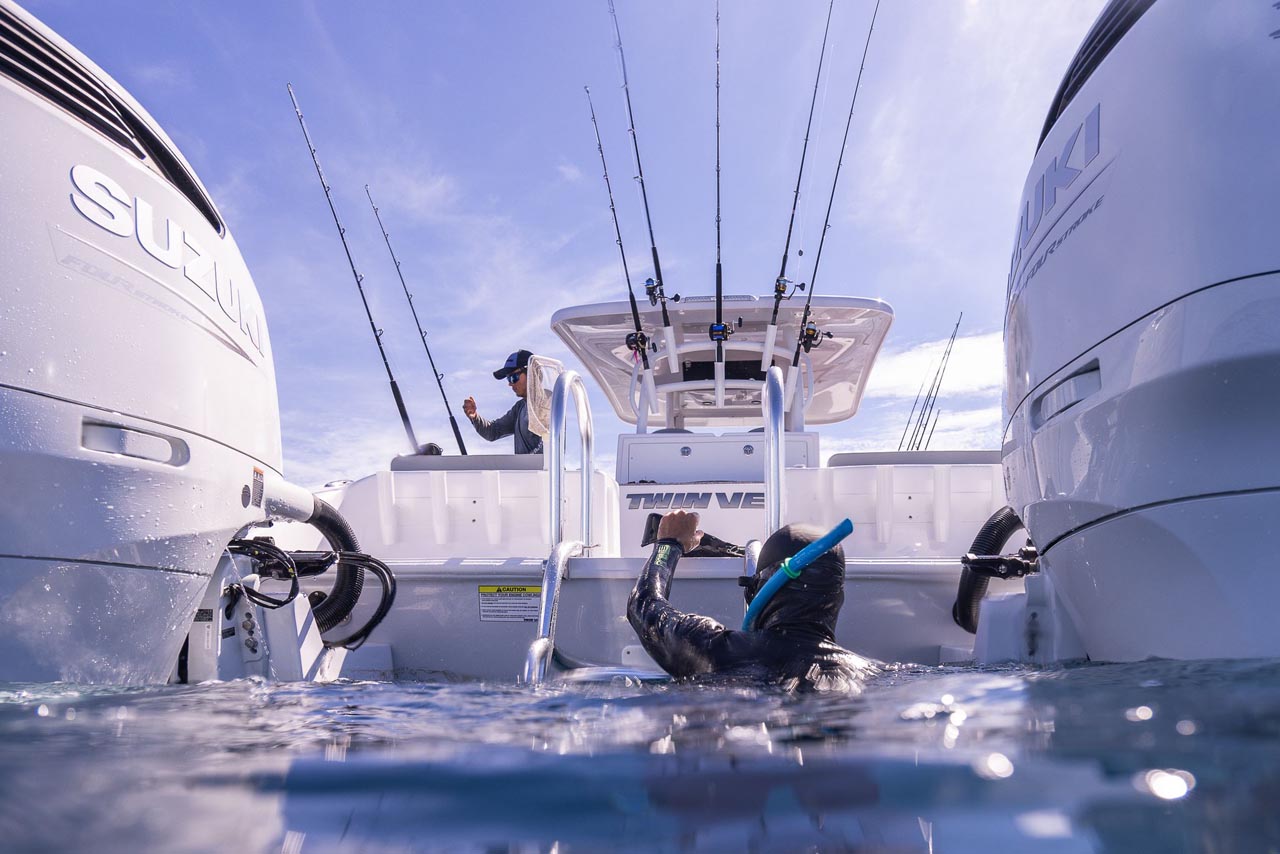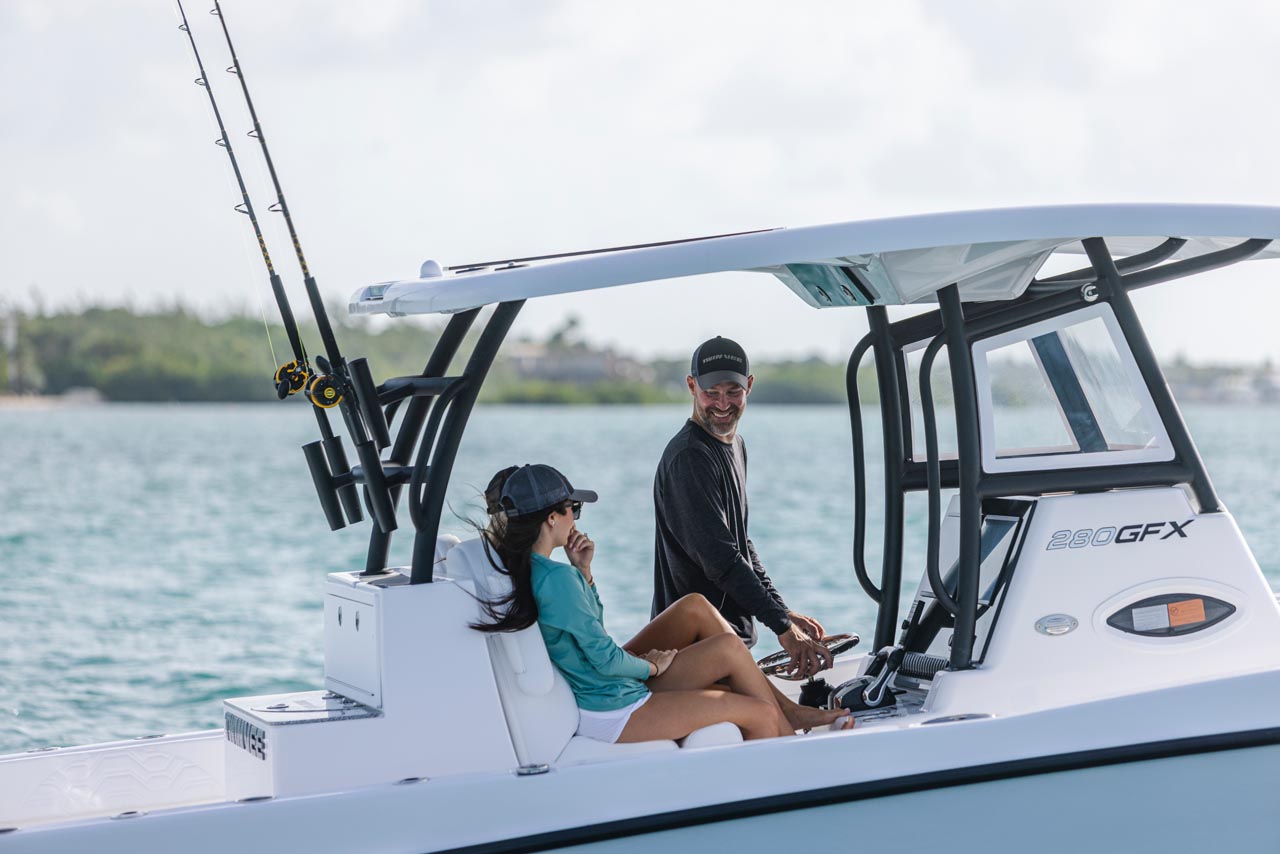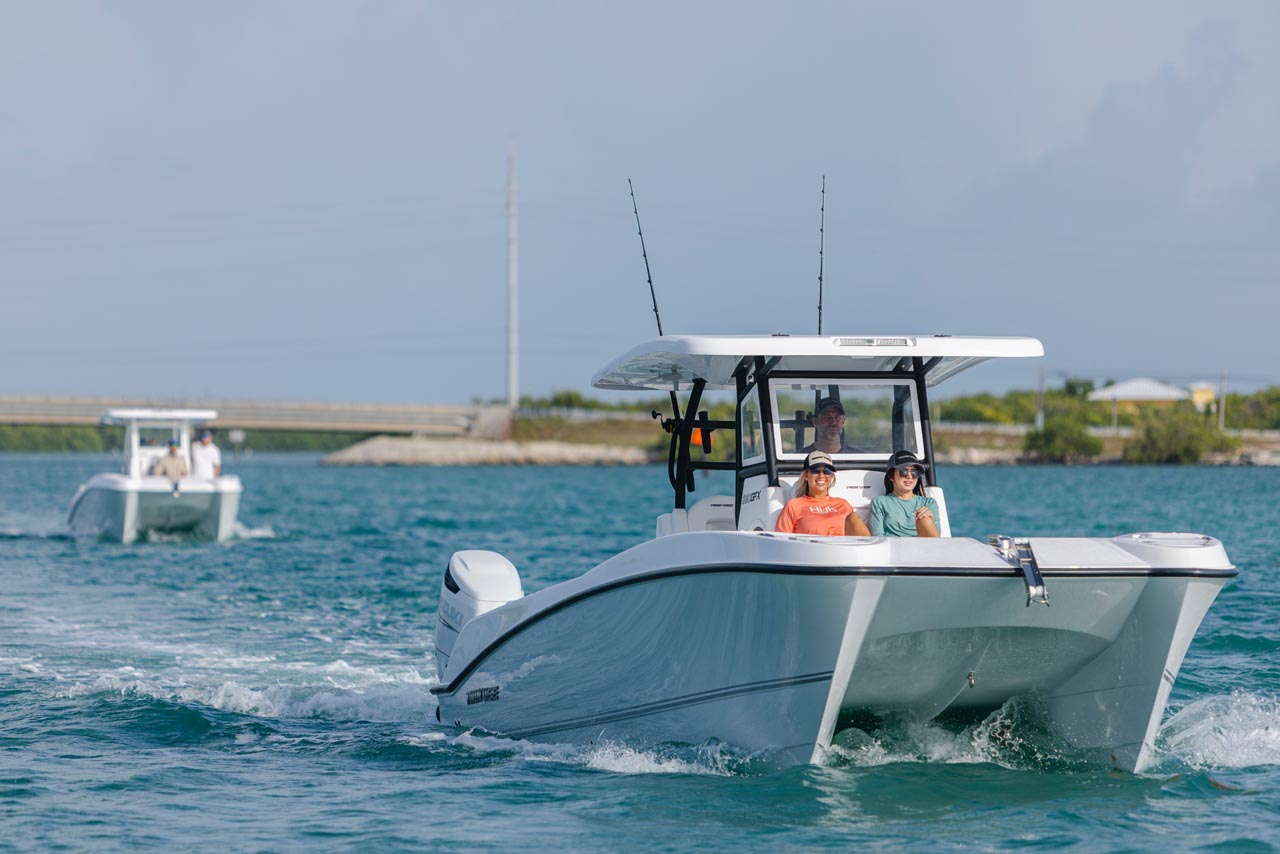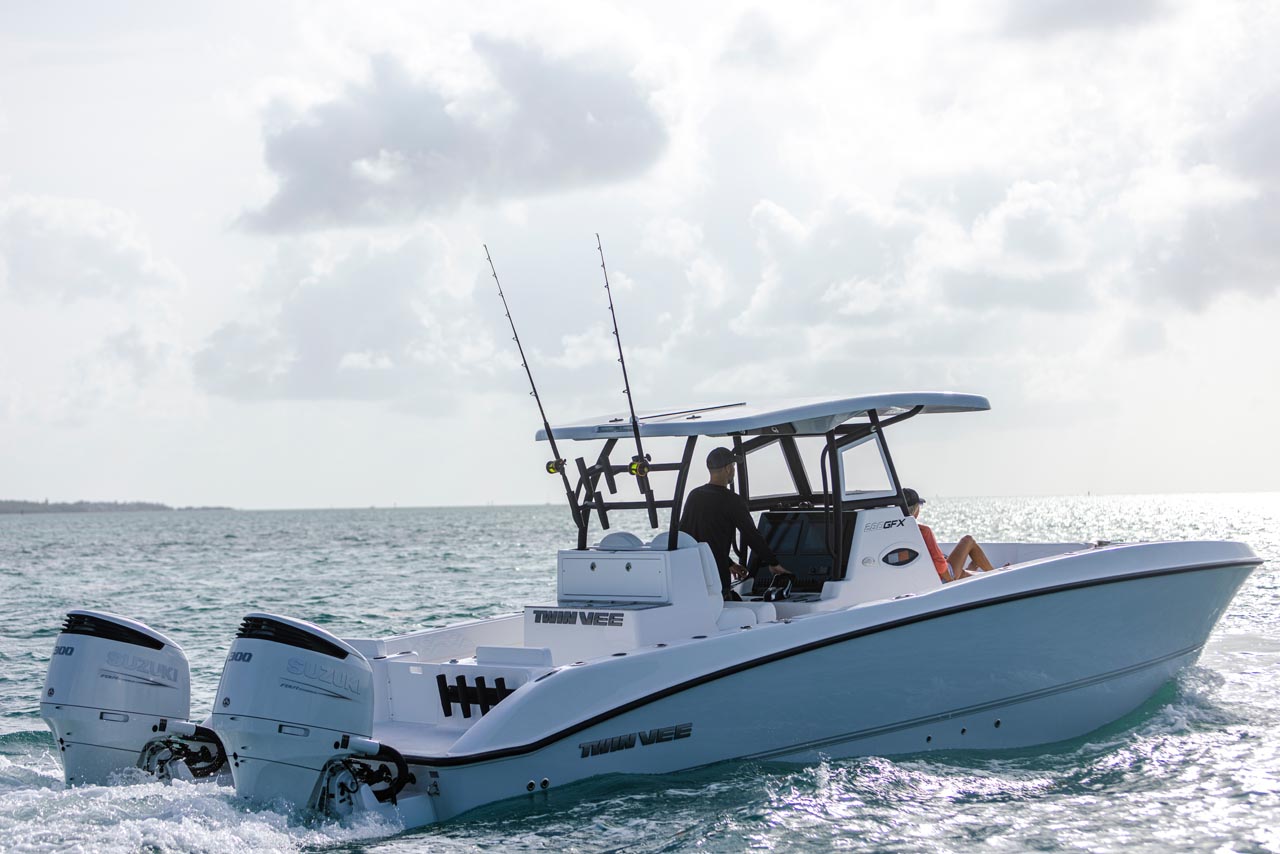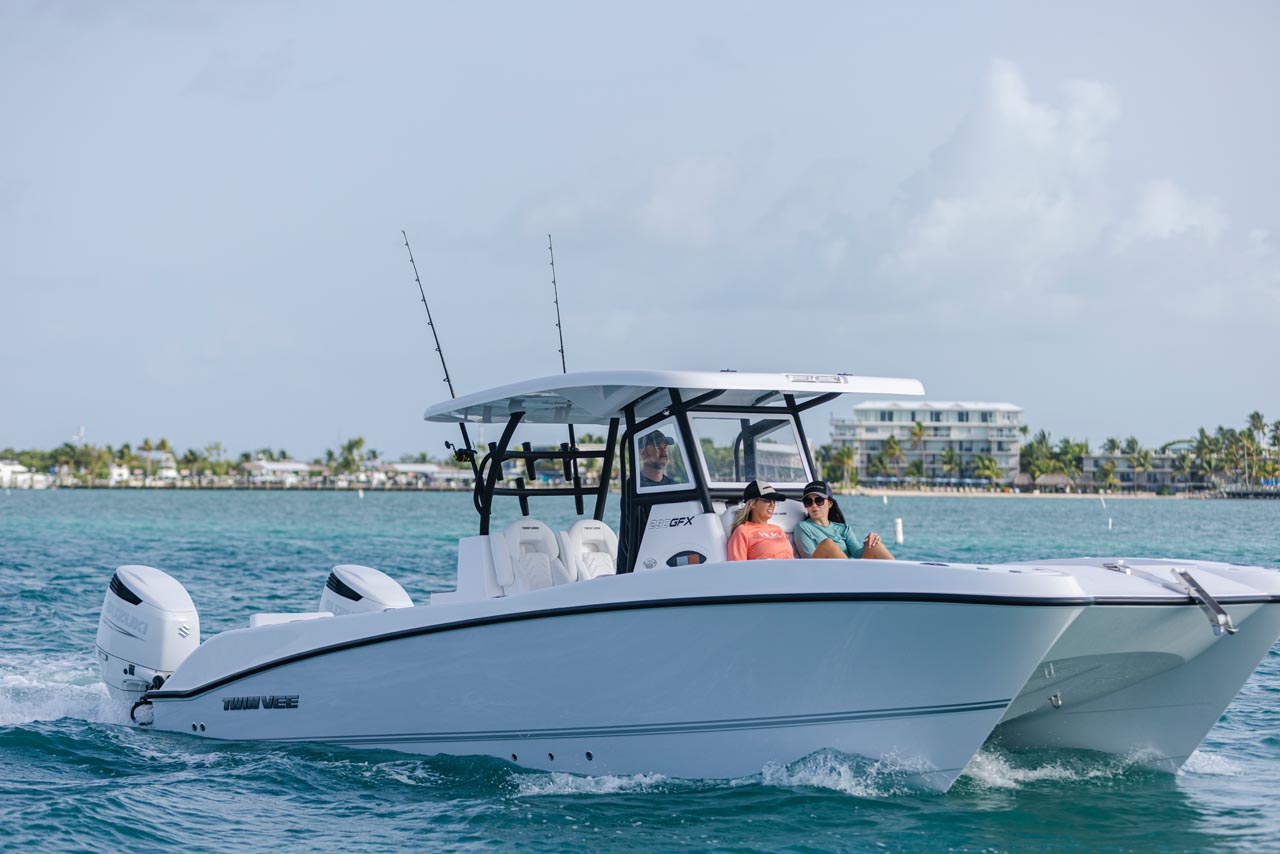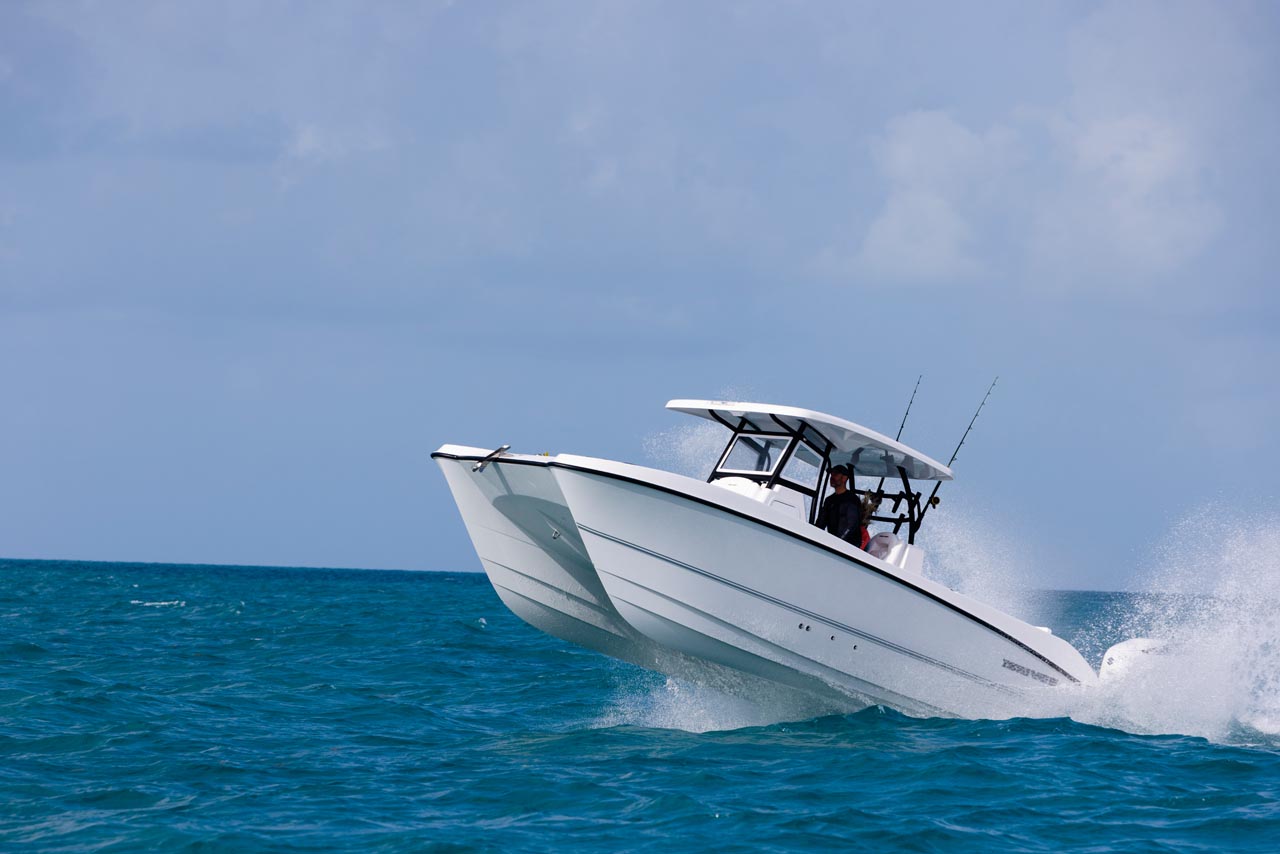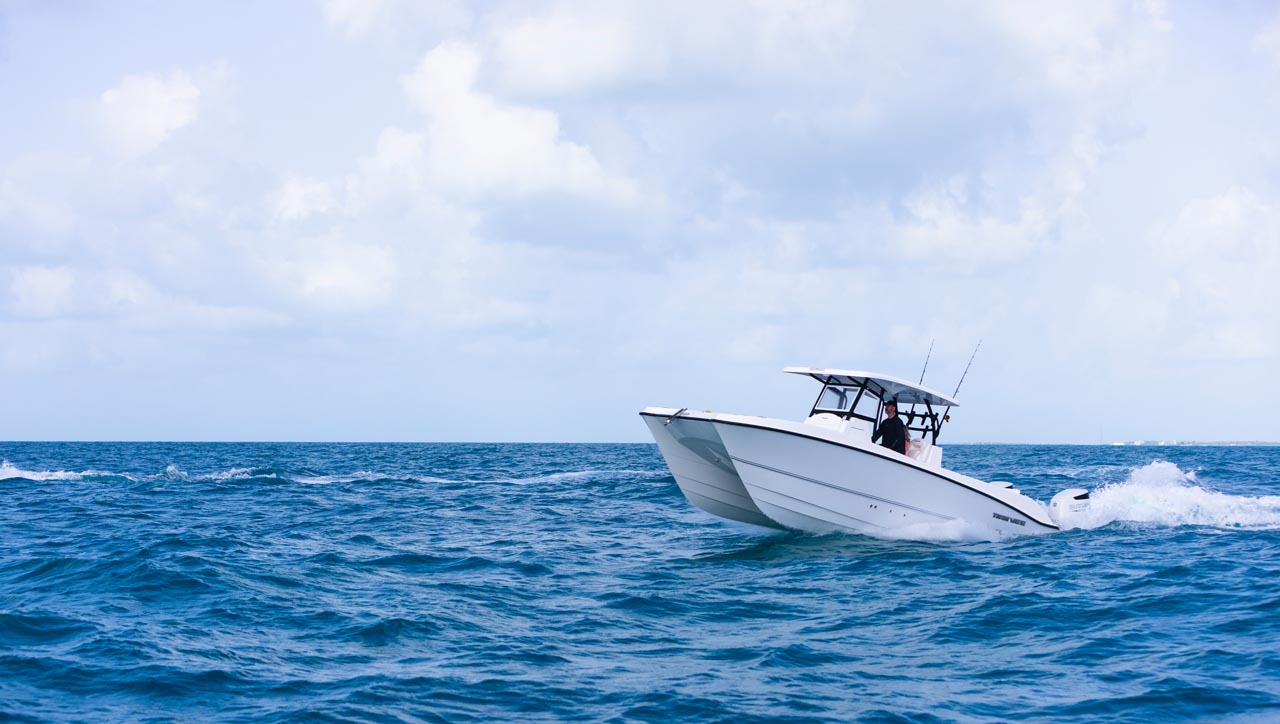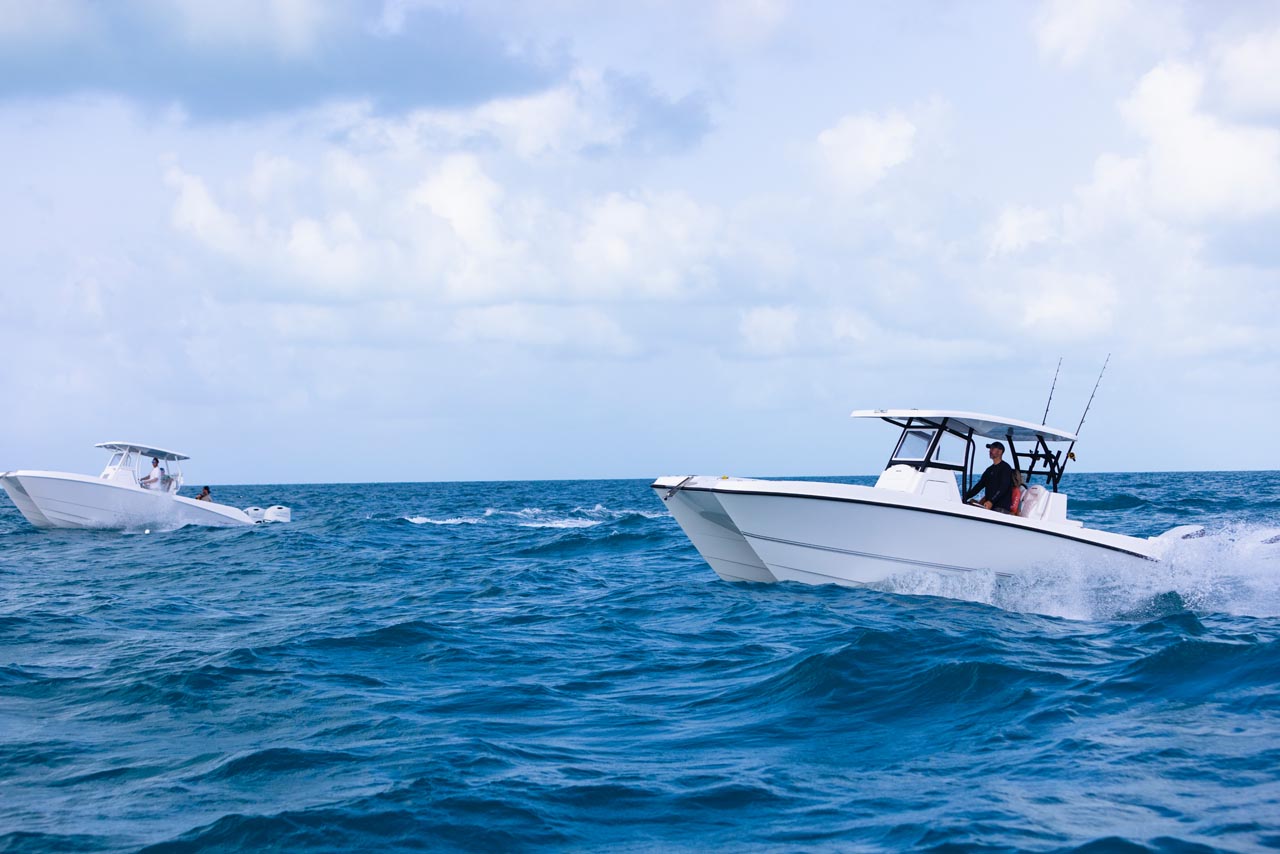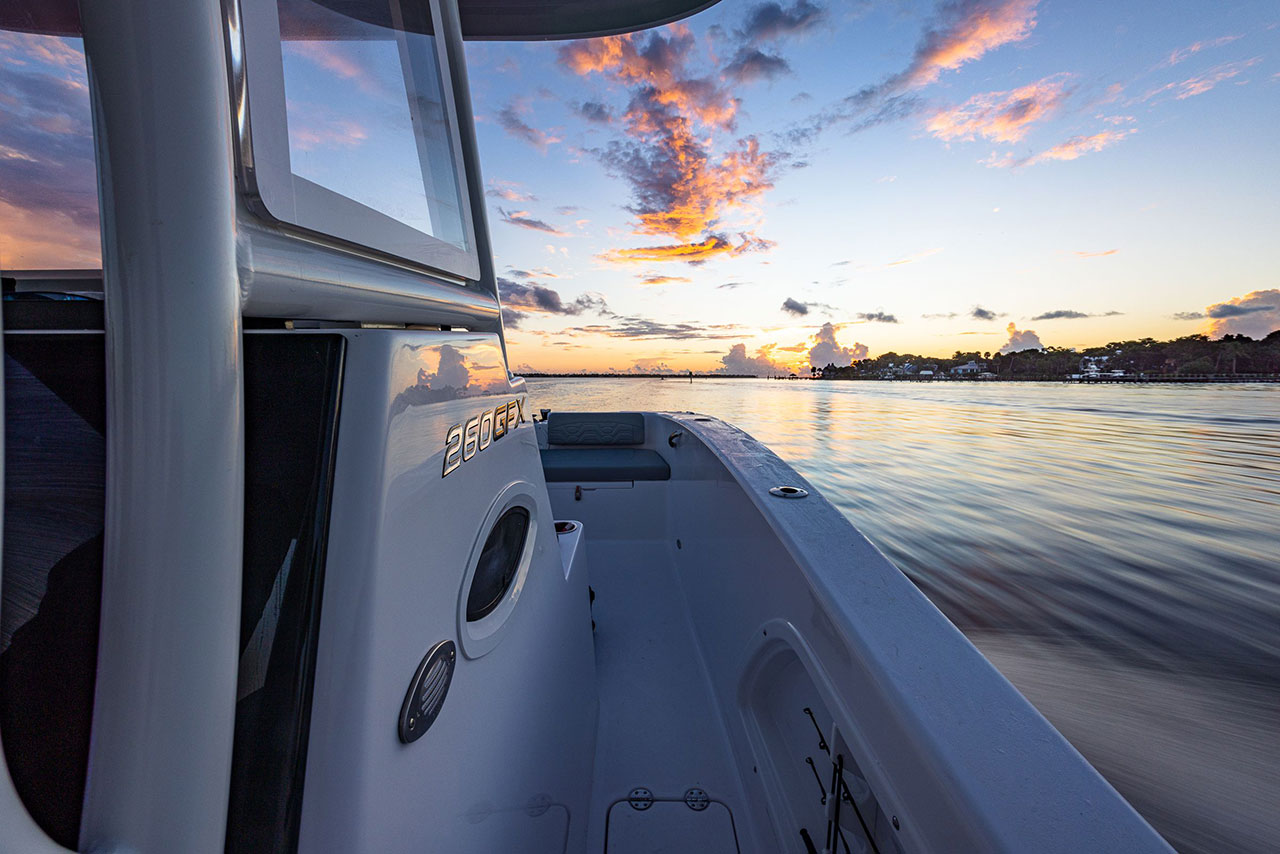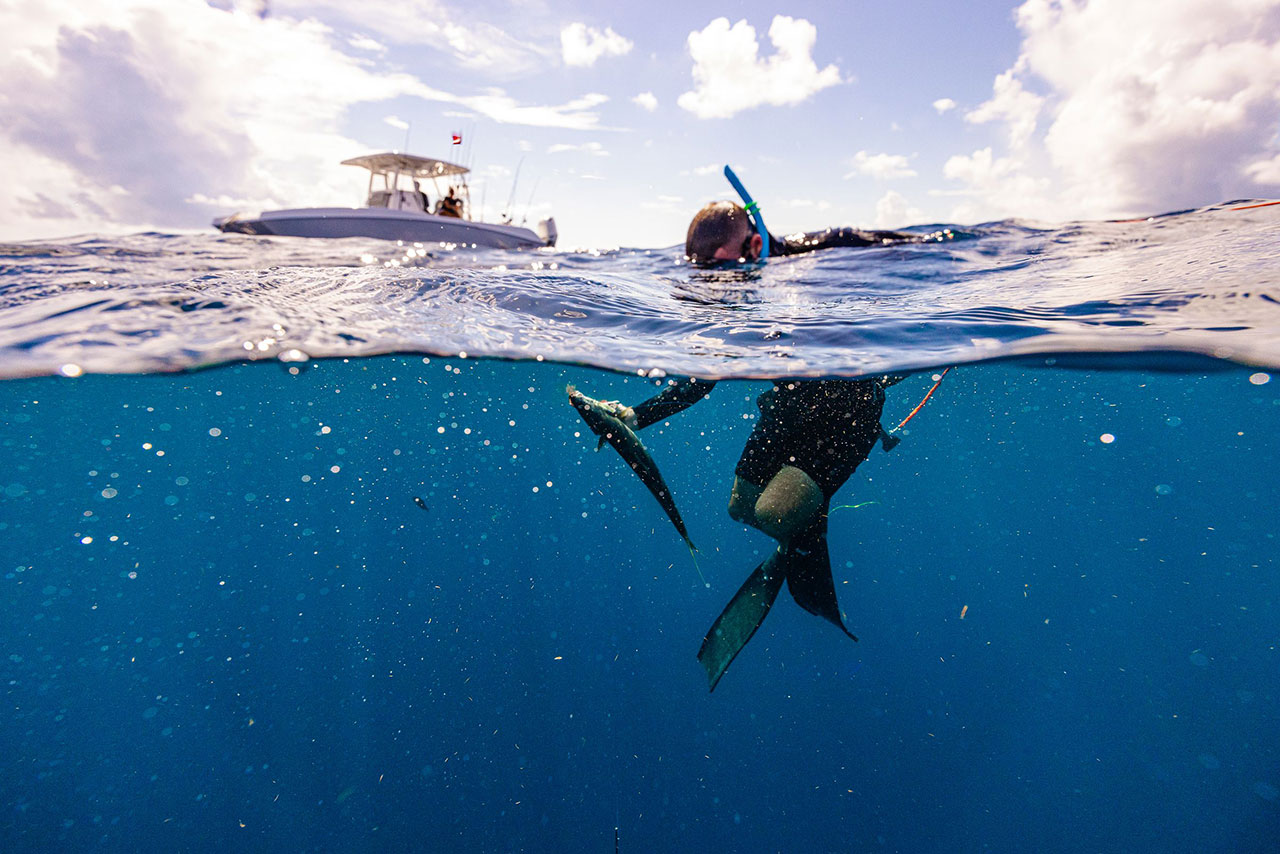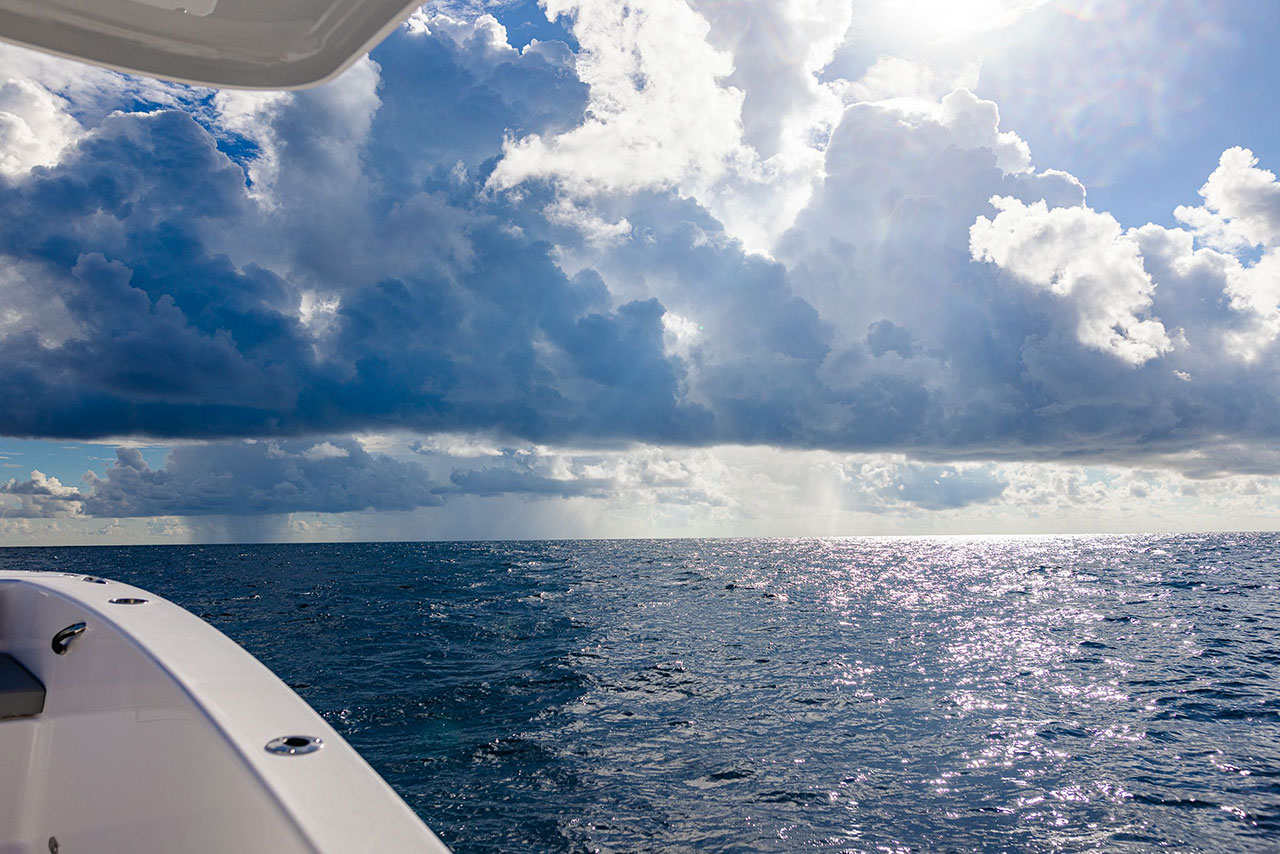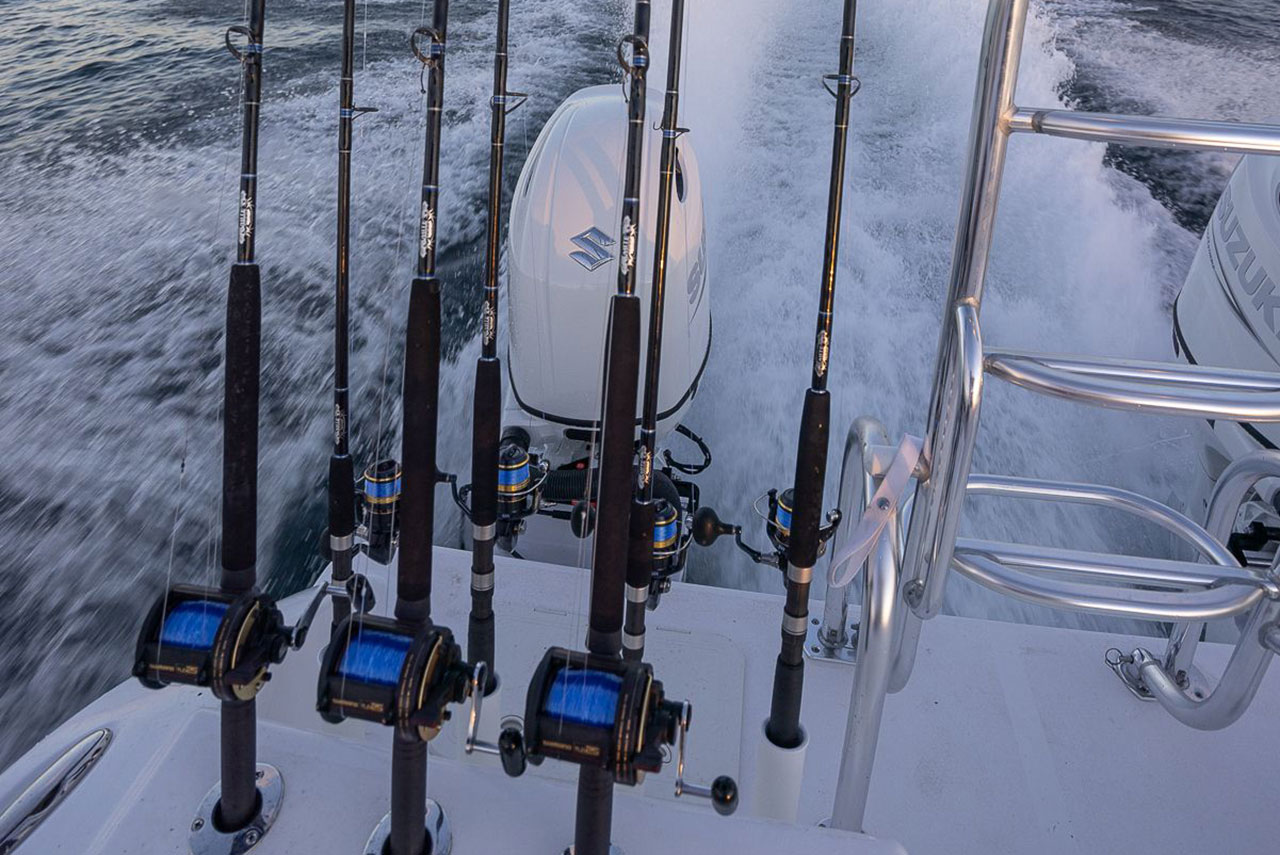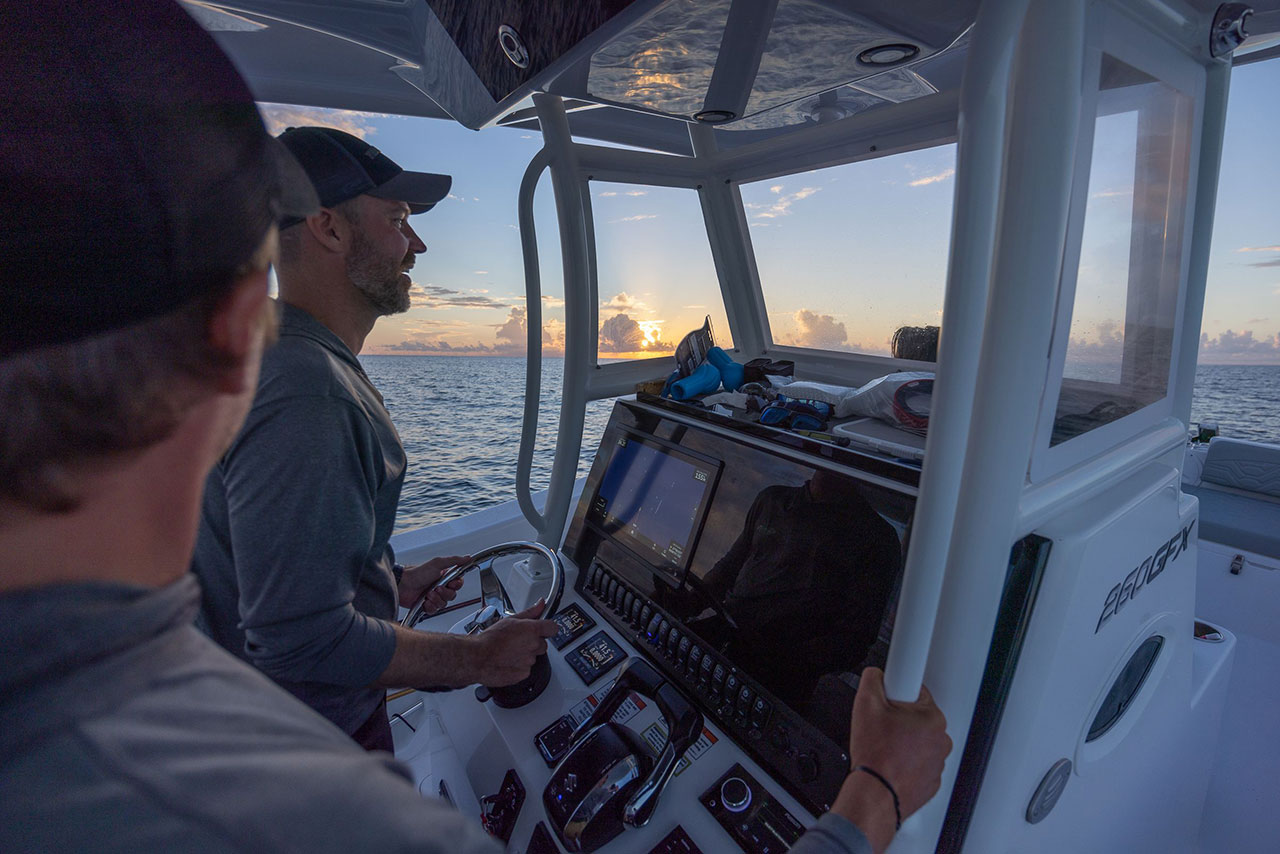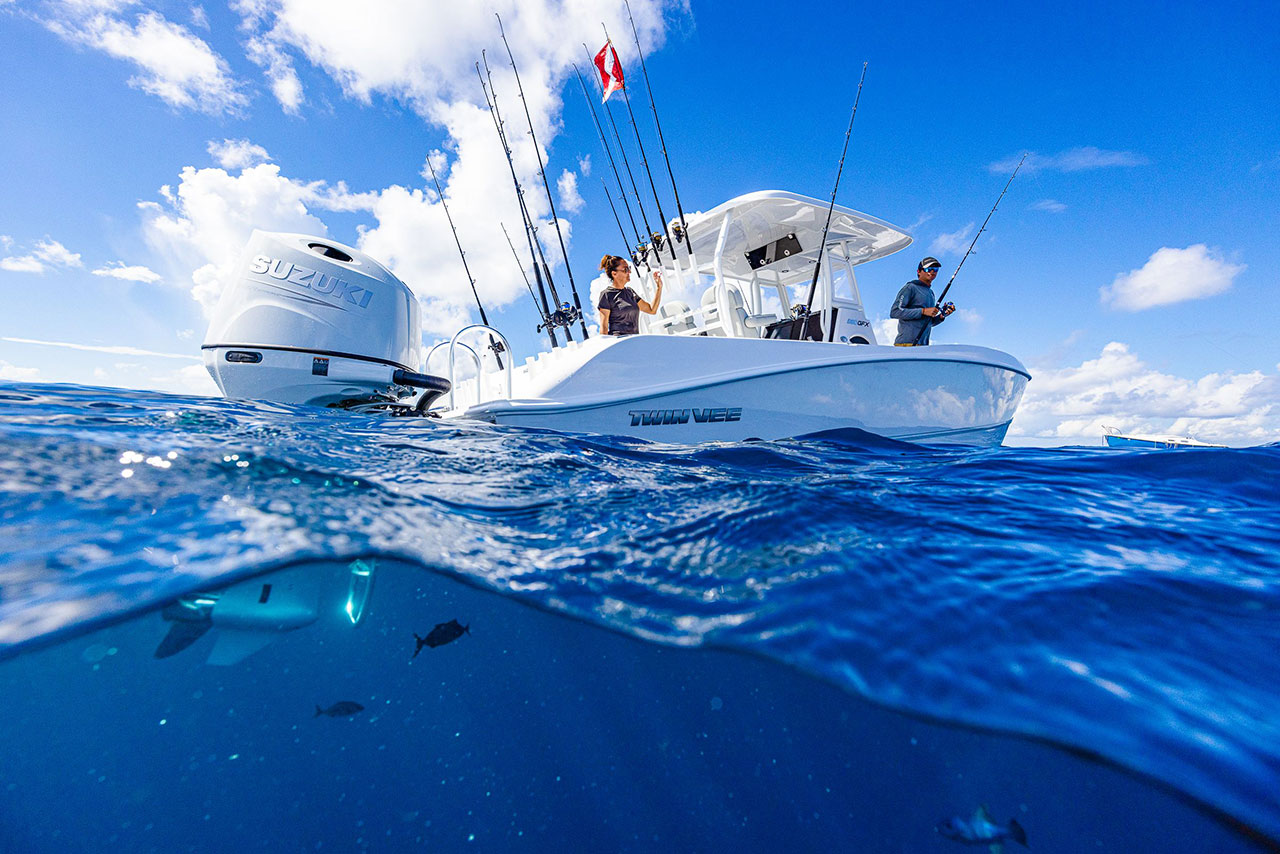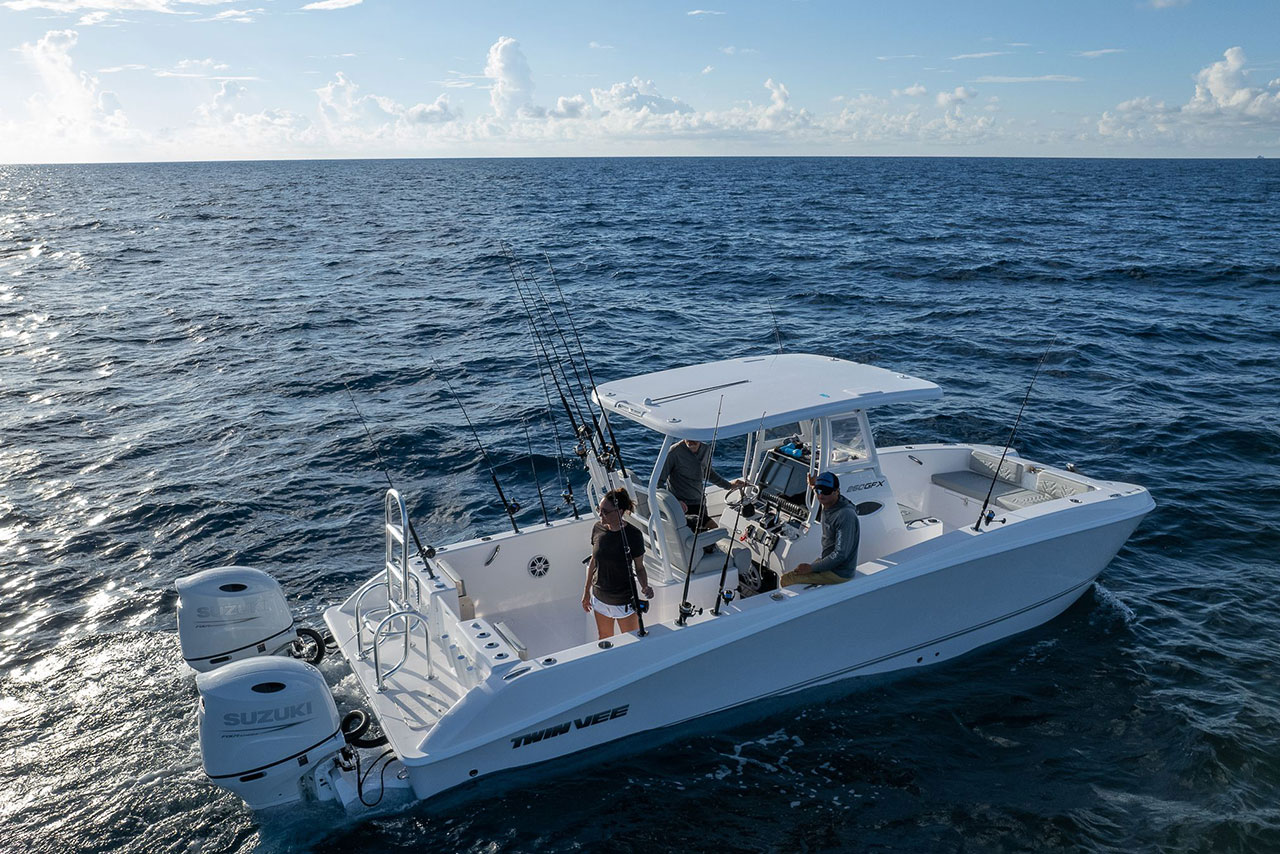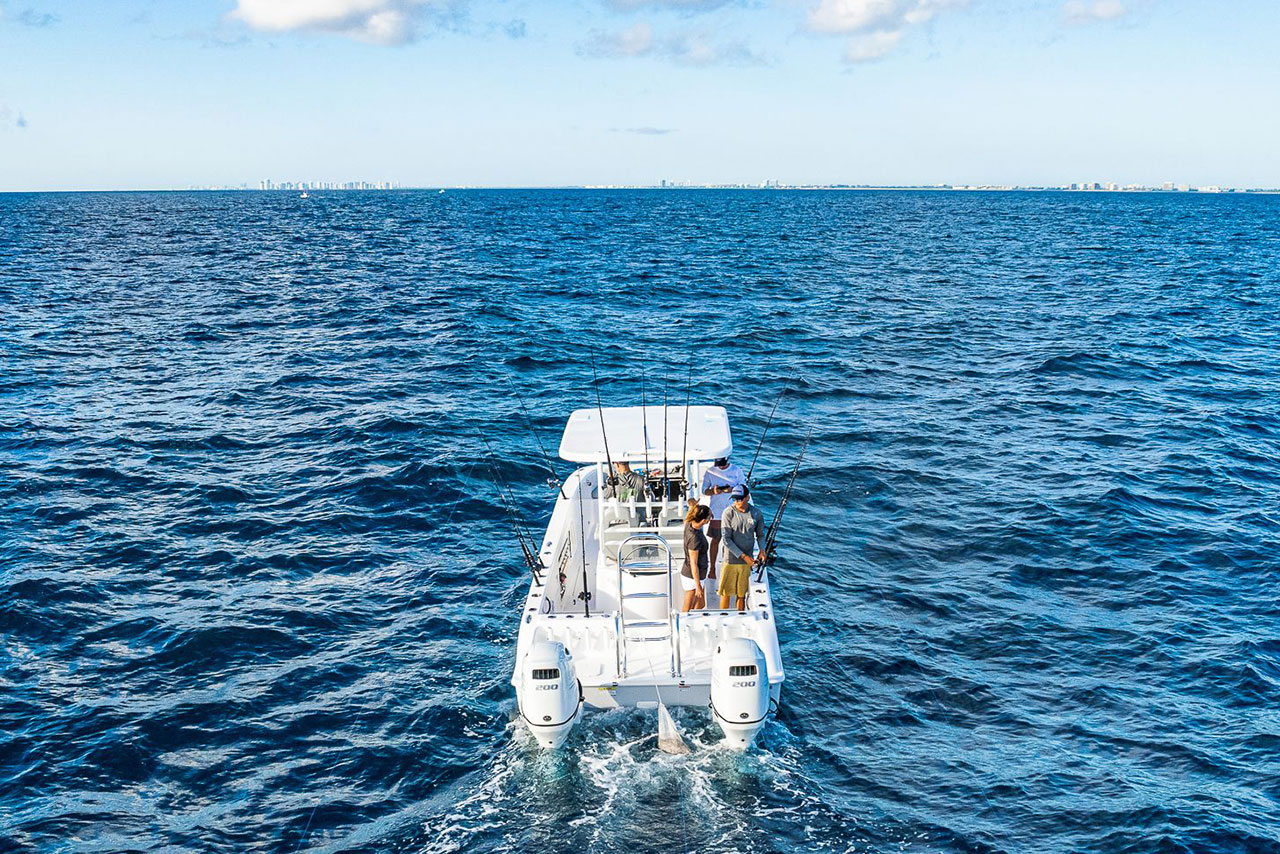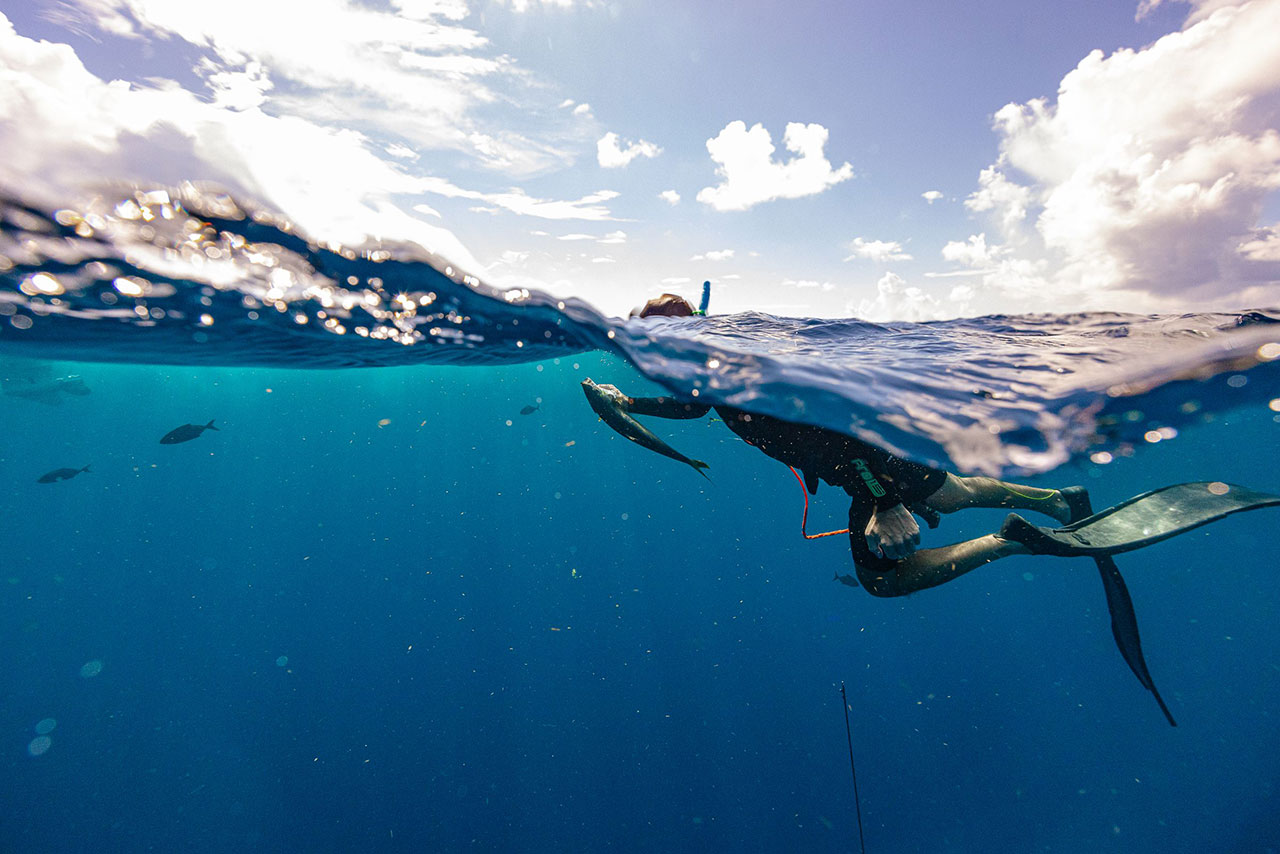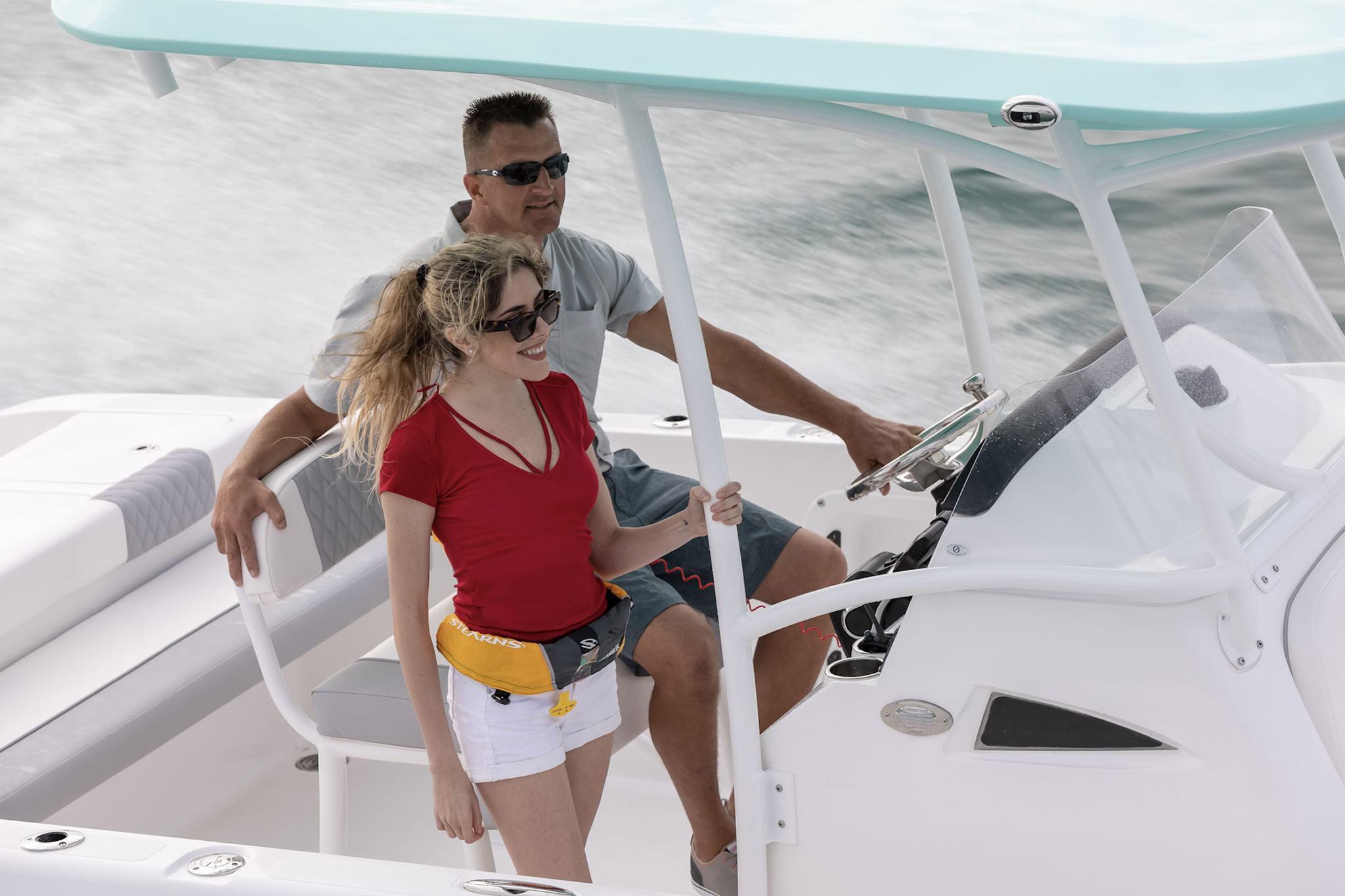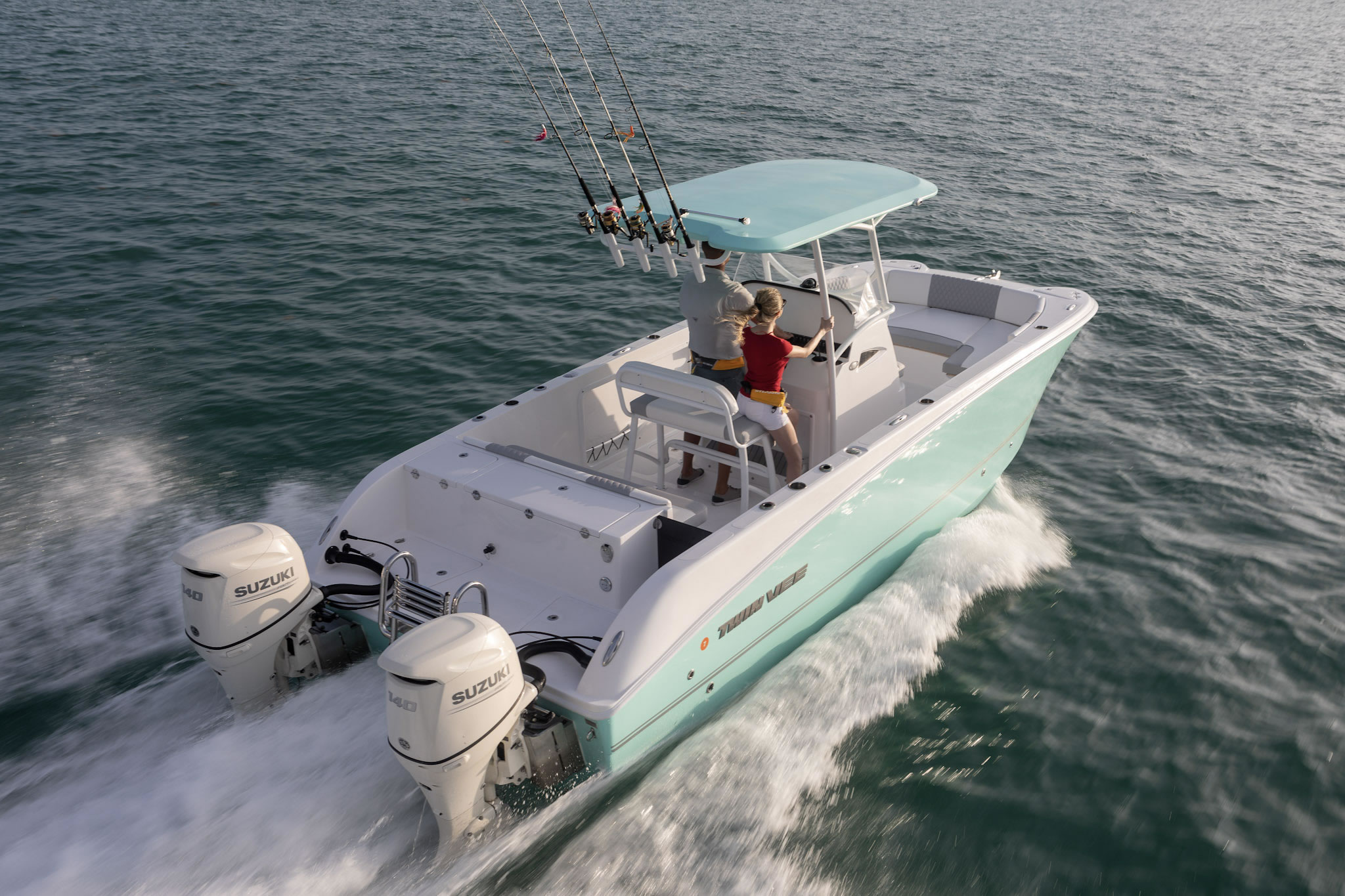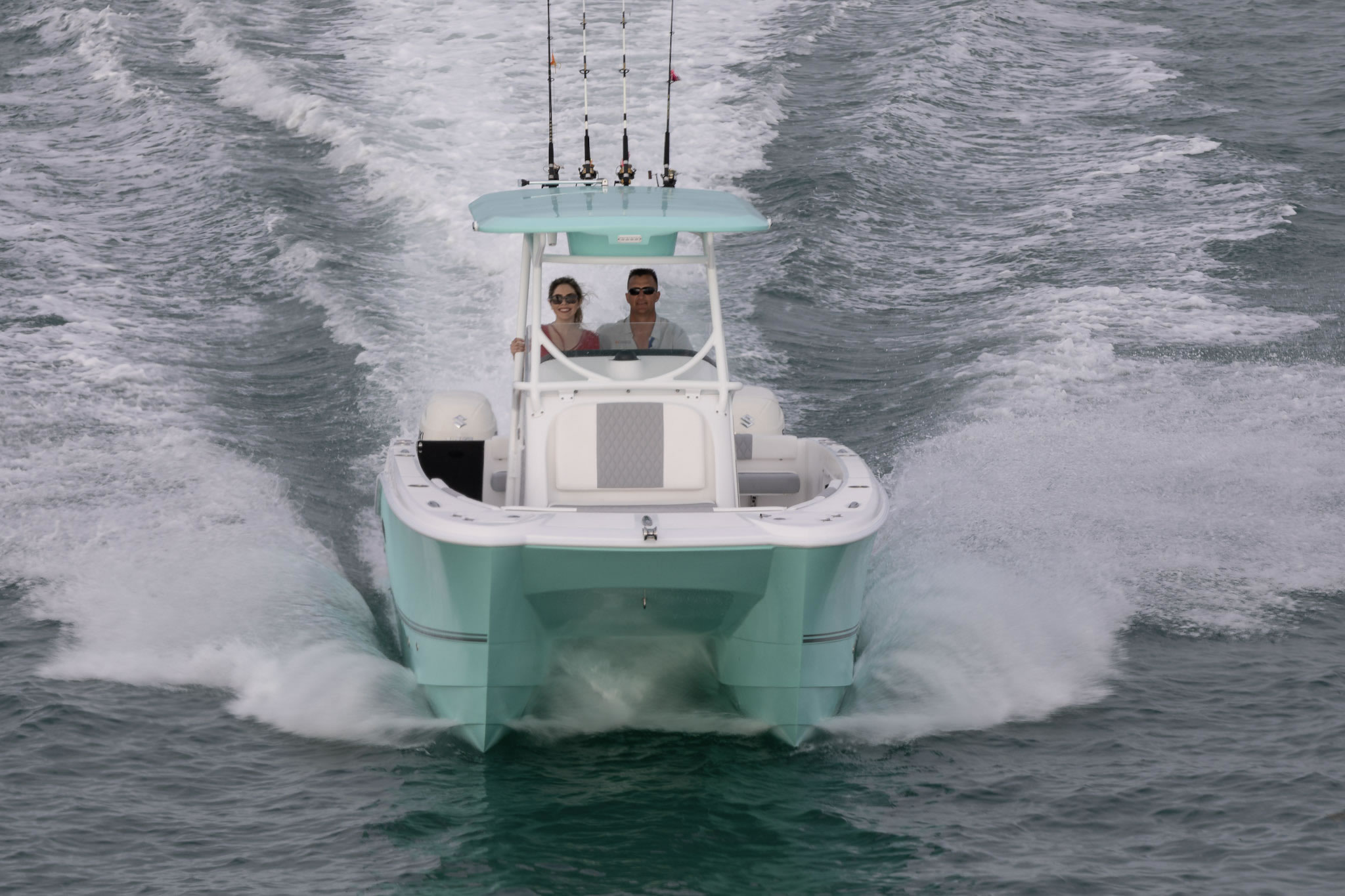How to Trim and Steer Twin Vee Powercats
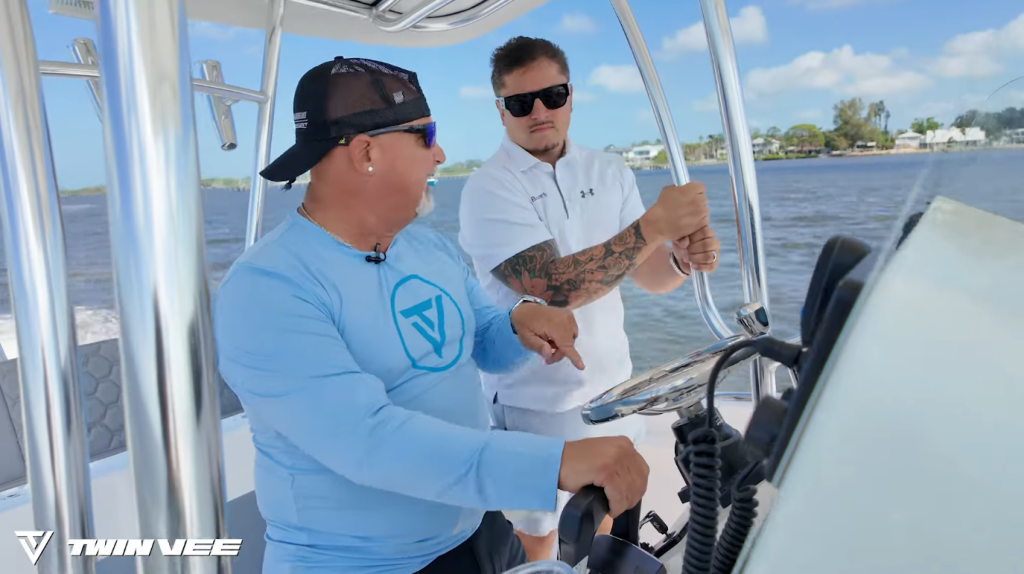
Catamarans handle differently than traditional monohulls, and Twin Vee owners quickly learn that mastering trim and steering makes all the difference between an average ride and an incredible one. This guide walks you through how to operate a Twin Vee the right way, whether you are at the helm of a 400 GFX2 offshore model or a 22 BayCat. Although each model does have its own nuances in handling, the principles are the same: manage trim to load the tunnel with air and water, and steer with small, deliberate inputs.
*A quick note before we jump into the guide.*
If you are considering purchasing your first Twin Vee and want hands-on guidance before or after making that decision, contact us to arrange a sea trial and factory tour.
Drawing from on-the-water demonstrations with Captain Skip, this tutorial breaks down what’s happening beneath the hull and how to use your controls to get the smooth, level ride Twin Vee is known for.
Understanding How a Twin Vee Hull Works
Every Twin Vee catamaran is designed to channel air and water down the tunnel between its twin sponsons. As speed increases, the tunnel fills with a mix of aerated water and lift pressure that cushions the boat from hard impact. The faster the boat runs, the more that air cushioned tunnel effect takes over. The hull is lifted higher out of the water and drag is reduced.
That’s why a Twin Vee actually prefers some chop instead of glass-flat calm waters. In moderate two- to three-foot seas, the tunnel packs with air, the hull rides higher, and you get that signature “floating on rails” sensation. If you’re used to monohulls, this may feel counterintuitive at first, but once you feel the lift, you’ll understand why cat owners chase a little chop.
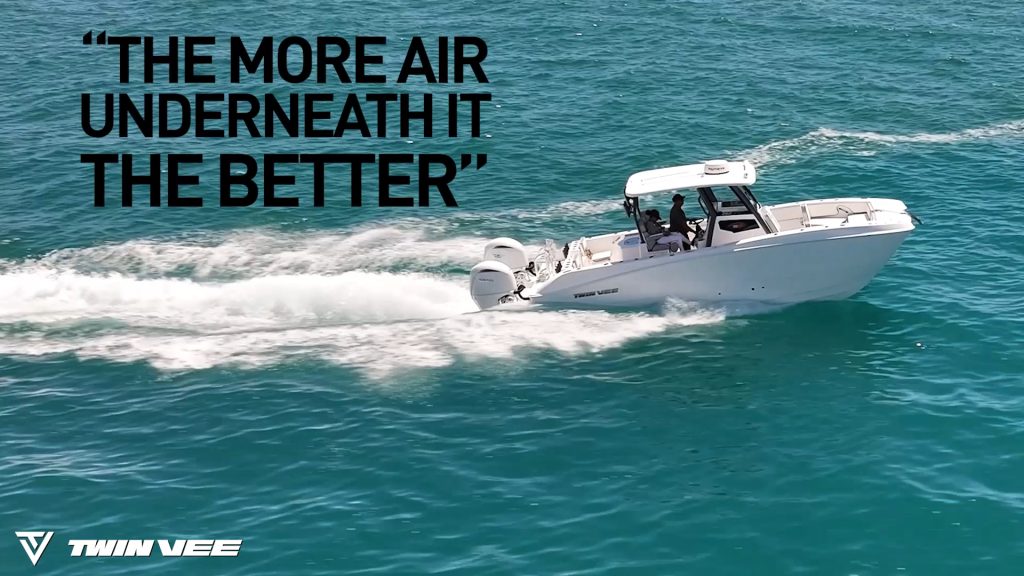
Trimming for Running Performance
Unlike monohulls that rely on hull shape or hydraulic trim tabs to adjust running attitude, a Twin Vee’s twin outboards handle that task. Each engine can be trimmed independently, or both together.
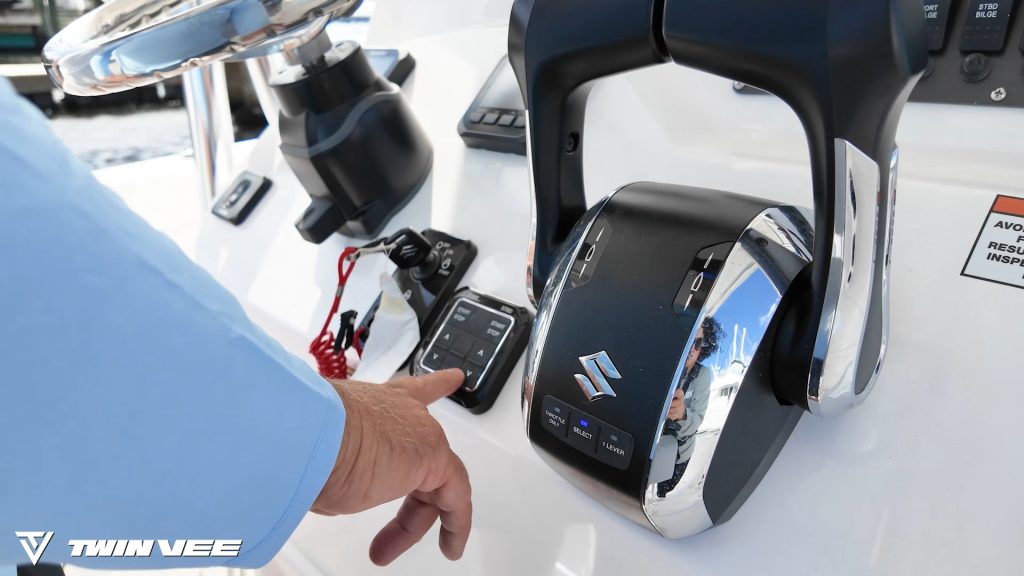
- The thumb switch on your throttle trims both motors simultaneously.
- The separate rocker or pad switches control each motor individually—port and starboard.
For the best results, start your takeoff with the engines trimmed around one-third up (roughly 35 percent). As the boat climbs on plane, continue trimming upward while watching your gauges or listening to the engines. You’ll usually end up near 70 percent trim.
When the props begin to cavitate (a brief change in tone or vibration) you’ve gone slightly too far. Tap the trim down just enough for the props to grab clean water again. That’s the “sweet spot.”
At proper trim, the spray line should move aft, breaking closer to the leaning post instead of the console. If you see spray forward of the helm, you’re running too flat.
Typical cruise speeds for Twin Vee offshore hulls fall between 30 and 38 MPH, where efficiency, comfort, and tunnel lift align. Many new operators instinctively trim too low because that’s what they were taught in monohulls. On a Twin Vee, trimming higher delivers the lift and soft ride the boat was built for.
Why Twin Vee Boats Don’t Use Trim Tabs
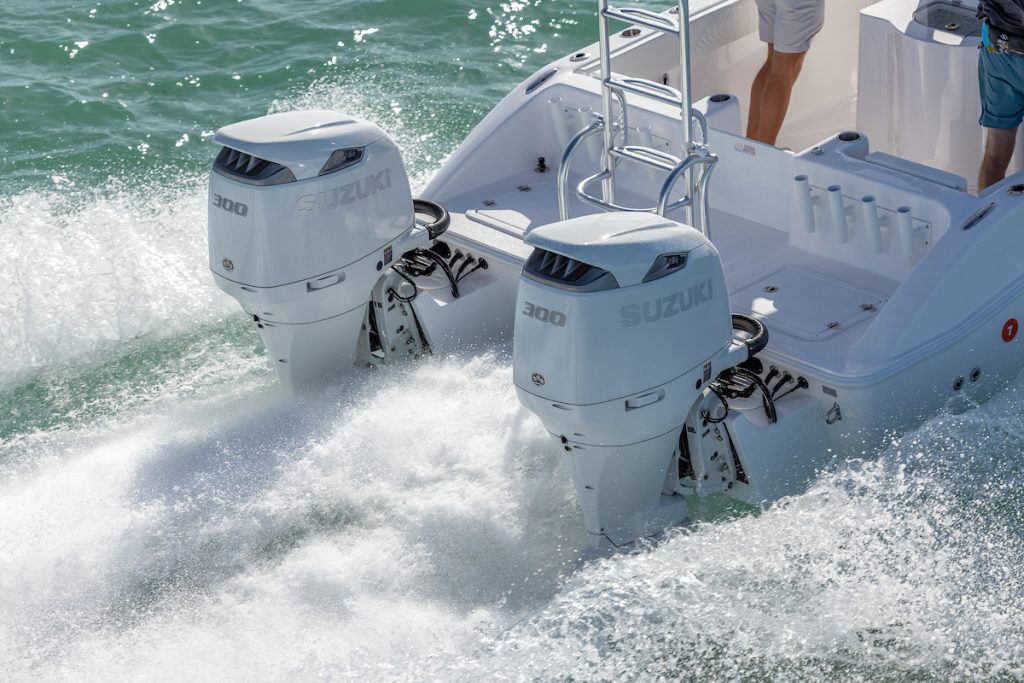
A frequent question from new owners is why Twin Vee doesn’t install traditional trim tabs on boats. The answer is simple: they aren’t needed.
The outboard motors themselves act as fully adjustable tabs. By trimming one engine down slightly, you create drag on that side of the boat, leveling any list caused by uneven passenger weight or gear.
For example, if extra people are seated on the port side and the boat leans slightly left, trim the port motor down just a touch. The added resistance lifts that side and evens the running attitude. Once level, bring both motors back up together to restore optimum trim.
This is great for when you need some additional adjustment, but the great thing about our powercats is that they have another method of built-in balance correction: their engine spacing.
Turning: Steering and Trim Coordination
Turning a Twin Vee requires a balance between throttle control and trim adjustment. Because the engines are spaced far apart, they do most of the work when it comes to maneuvering, and small, smooth inputs make all the difference.
When preparing for a turn, reduce throttle slightly on the engine on the inside of the direction you’re turning. For a port (left) turn, ease back the port throttle; for a starboard (right) turn, ease back the starboard throttle. This allows the outside engine to continue driving forward while the inside engine helps the boat pivot. The result is a flat, predictable turn rather than a hard lean or roll.
At the same time, you can use trim to help keep the boat level through the turn. Before a right turn, trim the port engine down slightly to create drag and lift the inside of the turn. Before a left turn, trim the starboard engine down. This adjustment acts like a built-in trim tab system and helps the boat carve through the turn smoothly.
Advanced Maneuvering

One of the biggest handling advantages of a Twin Vee comes from the wide spacing between its outboards. With the port motor in reverse and the starboard in forward, the boat can rotate nearly in place 360 degrees. This is a useful technique for docking, tight harbors, or spinning around to pick up a line.
Practice this at idle speed in open water before using it near a dock. Once you get a feel for how quickly the hull reacts, you’ll find it surprisingly intuitive.
Running in Chop and Waves

When approaching waves or crossing another boat’s wake, keep the boat trimmed up and maintain enough speed to stay on top of the water. Powering into a wave rather than backing off helps keep the bow elevated and prevents the tunnel from stuffing.
In Captain Skip’s test runs, the 340 GFX handled four foot waves at more than 30 MPH without losing prop bite or slamming. The twin-hull design disperses impact evenly, so you feel a soft, controlled landing instead of a jarring drop.
If you ever do need to slow down through heavier seas, avoid trimming fully down. Keep some lift in the tunnel so the boat rides on its designed cushion of air and water.
Weight Distribution and Stability
Catamarans are inherently more stable than monohulls because their wide stance and twin hulls resist roll. Even when several passengers move to one side, the boat lists only slightly. Demonstrations have shown that with multiple adults standing on one side and even on the gunnel, the opposite hull remains stable.
Still, trimming the low side engine down will immediately rebalance the boat. This is another advantage of using the engines as active trim devices instead of fixed tabs.
Getting Comfortable Behind the Wheel
Transitioning from a monohull to a catamaran takes a few trips to feel natural. Spend time experimenting with trim settings and throttle response in different sea conditions. Let the boat run. Twin Vees are designed to perform better the faster they go, provided they are trimmed correctly.
To prove this, many factory test drivers will take their hands off the wheel in light chop to show how straight the boat tracks when properly trimmed. The twin sponsons alternate small corrections on their own, keeping the boat arrow-straight even at 40 MPH.
Once you’ve experienced this stability, it becomes second nature.
Over-Correction: The Most Common Mistake
Once the turn is complete and the boat straightens out, return both trims to your normal cruising position and bring both throttles back up evenly. Avoid turning the wheel too aggressively. Over-steering or over-correcting can cause the hulls to roll from side to side, especially when trim is set too low. Operators transitioning from monohulls often react by snapping the wheel in the opposite direction when they feel one hull dip, but a Twin Vee will naturally stabilize itself as water pressure equalizes between the sponsons. If a correction is needed, make it gradually rather than sharply. Measured, precise inputs keep the boat flat, tracking cleanly through the turn with steady speed and minimal spray.
Other Common Handling Mistakes to Avoid
- Running with too little trim. Leads to wallowing, bow steering, and forward spray.
- Backing off too much in chop. Twin Vees perform best when they stay on top of the water with airflow in the tunnel.
- Ignoring individual trim. Use your separate engine controls to correct list and improve turns.
The Takeaway
Learning to trim and steer a Twin Vee is less about memorizing numbers and more about feeling what the boat wants. Trim high enough to feed air through the tunnel, steer with finesse, and let the wide stance of the hull work for you. The reward is a ride that stays level, fast, and comfortable when others are slowing down.
Twin Vee’s catamarans are engineered to deliver the best ride on the water. With some practice and understanding of how trim affects tunnel pressure, every owner can unlock that performance.


